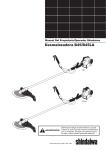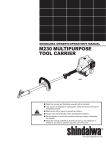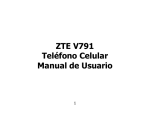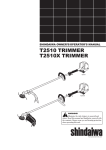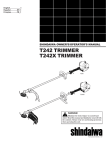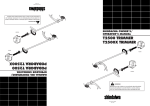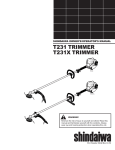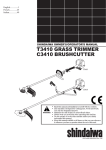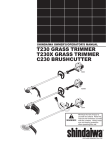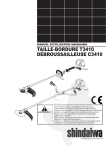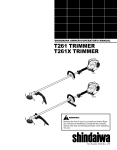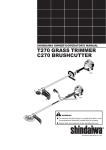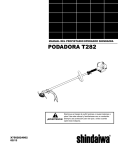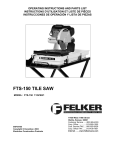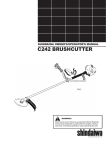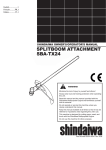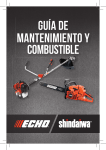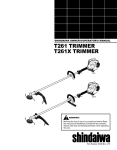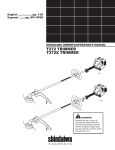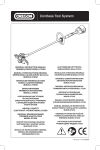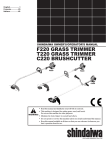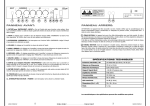Download T350 GRASS TRIMMER C350 BRUSHCUTTER
Transcript
SHINDAIWA OWNER’S/OPERATOR’S MANUAL T350 GRASS TRIMMER INTL Version C350 BRUSHCUTTER INTL, EMC Version T350 C350 WARNING! Minimize the risk of injury to yourself and others! Read this manual and familiarize yourself with the contents. Always wear eye and hearing protection when operating this unit. ® Part Number 72540-93112 Rev. 5/05 Introduction Attention Statements The Shindaiwa 350-series of hand power Throughout this manual are special tools has been designed and built to deattention statements. liver superior performance and reliability without compromise to quality, comfort, or durability. WARNING! Shindaiwa high performance engines A statement preceded by the trianrepresent the leading edge of 2-cycle gular attention symbol and the word engine technology, delivering exception“WARNING” contains information ally high power from remarkably low that should be acted upon to prevent displacement and weight. As an owner/ serious bodily injury. operator, you’ll soon discover for yourself why Shindaiwa is simply in a class by itself! CAUTION! IMPORTANT! The information contained in this manual describes units available at the time of publication. Shindaiwa Inc. reserves the right to make changes to products without prior notification, and without obligation to make alterations to units previously manufactured. A statement preceded by the word “CAUTION” contains information that should be acted upon to prevent mechanical damage. IMPORTANT! A statement preceded by the word “IMPORTANT” is one that possesses special significance. NOTE: Contents PAGE Attention Statements .............................2 General Safety Instructions ..................3 Checking Unit Condition ......................3 Safety Labels ...........................................5 Unit Description .....................................6 Specifications ..........................................6 Assembly .................................................7 Mixing Fuel ..........................................12 Starting the Engine ..............................13 Stopping the Engine ............................14 Idle Speed Adjustment ........................14 Shoulder Strap and Harness ...............15 Cutting Grass (trimmer head) ...........15 Using a Brushcutter Blade .................16 Maintenance .........................................17 Spark Arrester ......................................19 Long Term Storage ..............................19 Blade Sharpening .................................19 Troubleshooting Guide .......................20 A statement preceded by the word “NOTE” contains information that is handy to know and may make your job easier. Read and follow this operators manual. Failure to do so could result in serious injury. Wear eye and hearing protection at all times during the operation of this unit. Keep bystanders at least 50 feet (15 m) away during operation. Beware of thrown or ricocheted objects. Do not operate this unit with a blade unless the unit is equipped with a Shindaiwa-approved handlebar or barrier. Always wear a harness when operating this unit with a blade. A harness is also recommended when using trimmer line. If unit is used as a brushcutter, beware of blade thrust. A jammed blade can cause the unit to jerk suddenly and may cause the operator to lose control of the unit. 2 IMPORTANT! The operational procedures described in this manual are intended to help you get the most from this unit as well as to protect you and others from harm. These procedures are guidelines for safe operation under most conditions, and are not intended to replace any safety rules and/or laws that may be in force in your area. If you have questions regarding your Shindaiwa power tool, or if you do not understand something in this manual, your Shindaiwa dealer will be glad to assist you. You may also contact Shindaiwa, Inc. at the address printed on the back of this manual. Checking Unit Condition Work Safely Stay Alert Trimmers and brushcutters operate at very high speeds and can do serious damage or injury if they are misused or abused. Never allow a person without training or instruction to operate this unit! You must be physically and mentally fit to operate this unit safely. NEVER operate the unit with the cutting attachment shield or other protective devices (harness, ignition switch, blade retention clip, etc.) removed! WARNING! Never make unauthorized attachment installations. WARNING! WARNING! Never operate power equipment of any kind if you are tired or if you are under the influence of alcohol, drugs, medication or any other substance that could affect your ability or judgement. Use Good Judgment NEVER operate the engine when transporting the unit. NEVER operate the engine indoors! Make sure there is always good ventilation. Fumes from engine exhaust can cause serious injury or death. ALWAYS use the proper cutting tool for the job. ALWAYS stop the unit immediately if it suddenly begins to vibrate or shake. Inspect for broken, missing or improperly installed parts or attachments. NEVER extend trimming line beyond the length specified for your unit. ALWAYS keep the unit as clean as practical. Keep it free of loose vegetation, mud, etc. ALWAYS hold the unit firmly with both hands when cutting or trimming, and maintain control at all times. ALWAYS keep the handles clean. ALWAYS disconnect the spark plug wire before performing any maintenance work. WARNING! Minimize the Risk of Fire NEVER smoke or light fires near the unit. ALWAYS stop the engine and allow it to cool before refueling. Avoid overfilling and wipe off any fuel that may have spilled. ALWAYS inspect the unit for fuel leaks before each use. During each refill, check that no fuel leaks from around the fuel cap and/or fuel tank. If fuel leaks are evident, stop using the unit immediately. Fuel leaks must be repaired before using the unit. ALWAYS move the unit to a place well away from a fuel storage area or other readily flammable materials before starting the engine. NEVER place flammable material close to the engine muffler. WARNING! A cutting attachment shield or other protective device is no guarantee of protection against ricochet. YOU MUST ALWAYS GUARD AGAINST FLYING DEBRIS! Use only authorized Shindaiwa parts and accessories with your Shindaiwa trimmer or brushcutter. Do not make modifications to this unit without the written approval of Shindaiwa, Inc. ALWAYS make sure the cutting attachment is properly installed and firmly tightened before operation. NEVER use a cracked or warped cutting attachment. If a properly installed attachment vibrates, replace the attachment with new one and recheck. ALWAYS stop the engine immediately and check for damage if you strike a foreign object or if the unit becomes tangled. Do not operate with broken or damaged equipment. NEVER allow the engine to run at high RPM without a load. Doing so could damage the engine. NEVER operate a unit with worn or damaged fasteners or attachment holders. NEVER cut with a dull blade. Doing so will increase the risk of blade thrust and may also cause equipment damage. ALWAYS, if a blade should bind fast in a cut, shut off the engine immediately. Push the branch or tree to ease the bind and free the blade. IMPORTANT! This unit does not have the spark arrester installed in the muffler. Before placing the brushcutter in service, check local, state and federal regulations to determine if a spark arrester is required in your area. 3 SAFETY General Safety Instructions The Properly Equipped Operator SAFETY Wear hearing protection devices and a broadbrimmed hat or helmet. Always wear eye protection such as goggles or safety glasses to shield against thrown objects. Always wear a harness when operating a unit equipped with a blade. Wear close-fitting clothing to protect legs and arms. Gloves offer added protection and are strongly recommended. Do not wear clothing or jewelry that could get caught in machinery or underbrush. Secure long hair so that it is above shoulder level. NEVER wear shorts! Always operate with both hands firmly gripping the unit. When operating with a blade, make sure the handle is positioned to provide you with maximum protection from contacting the blade. Keep a proper footing and do not overreach. Maintain your balance at all times during operation. Always make sure the appropriate cutting attachment shield is correctly installed and in good condition. Keep away from the rotating trimmer line or blade at all times, and never lift a moving attachment above waist-high. Wear appropriate footwear (non-skid boots or shoes): do not wear open-toed shoes or sandals. Never work barefooted! Figure 1 Be Aware of the Working Environment Avoid long-term operation in very hot or very cold weather. Make sure bystanders or observers outside the 50-foot “danger zone” wear eye protection. If contact is made with a hard object, stop the engine and inspect the cutting attachment for damage. Be extremely careful of slippery terrain, especially during rainy weather. 50 FEET Reduce the risk of bystanders being struck by flying debris. Make sure no one is within 50 feet (15 meters)—that’s about 16 paces— of an operating attachment. ALWAYS clear your work area of trash or hidden debris that could be thrown back at you or toward a bystander. When operating in rocky terrain or near electric wires or fences, use extreme caution to avoid contacting such items with the cutting attachment. Beware of a coasting blade when brushcutting. A coasting blade can injure while it continues to spin after the throttle trigger is released or after the engine is stopped. Be constantly alert for objects and debris that could be thrown either from the rotating cutting attachment or bounced from a hard surface. Figure 2 4 Safety Labels SAFETY 35001 T350 This label indicates the minimum distance between front handle and rear grip per ANSI B175.3. 35002 C350 IMPORTANT! Safety and Operation Information Labels: Make sure all information labels are undamaged and readable. Immediately replace damaged or missing information labels. New labels are available from your local authorized Shindaiwa dealer. Figure 3 5 Unit Description Using the accompanying illustrations as a guide, familiarize yourself with this unit and its various components. Understanding this unit helps ensure top performance, long service life, and safer operation. T350 GRASS TRIMMER Handle (for trimmer use only; handlebar is required for brushcutting) Grip Ignition Switch Prior to Assembly 35001 Before assembling this product, please make sure you have all the components required for a complete unit: Engine assembly (Powerhead) DESCRIPTION Gearcase Outer Tube Assembly Cutting Attachment Shield Cutting attachment (trimmer head or brushcutter blade) Tool kit including: Hex wrenches and a combination spark plug wrench/screwdriver. Throttle Trigger Hanger Cutting Attachment shield Correct operator handle for application (see preceding page). Fuel Tank Outer Tube Trimmer Head C350 Brushcutter Ignition Switch Carefully inspect all components for damage. Throttle Trigger IMPORTANT! Cylinder Cover Hanger 35002 The terms “left,” “left-hand,” and “LH”: “right,” “righthand,” and “RH”; “front” and “rear” refer to directions as viewed by the operator during normal operation of this product. Fuel Tank Outer Tube Gearcase Handlebar Cutting Attachment Shield WARNING! Do not make unauthorized modifications or alterations to this unit or its components. Specifications Brushcutter Blade Figure 4 Engine Model ...........................................................................................................................................................................S350 Engine Dry weight C350 ........................................................................................................................................................... 16.8 pounds/7.6kg Dry weight T350 ........................................................................................................................................................ 15.2 pounds/6.9 kg. Type .................................................................................................................................................... 2-cycle, vertical cylinder, air cooled Bore x Stroke........................................................................................................................................................................36mm x 33mm Displacement ................................................................................................................................................................... 33.6.cc/2.1 cu. in. Maximum Power Output .................................................................................................................................. 1.8 hp @ 7500 rpm (min-1) Operating rpm Range .............................................................................................................................................5500–8500 rpm (min-1) Transmission Type ................................................................................................... Automatic centrifugal clutch through bevel gears Fuel/Oil Ratio .............................................................................................................. 50:1 with Shindaiwa Premium 2-cycle mixing oil Fuel Tank Capacity, T350 .................................................................................................................................................... 34 oz./1000 ml Fuel Tank Capacity, C350 .................................................................................................................................................... 34 oz./1000 ml Carburetion ................................................................................................................................................................. TK, Diaphragm type Ignition ............................................................................................................................................Fully electronic, transistor controlled Spark Plug...................................................................... Champion CJ-8 For electromagnetic (EMC) compliance, use NGK BMR6A Air Cleaner .............................................................................................................................................................................Foam element Starting Method ..................................................................................................................................................................................Recoil Stopping Method.......................................................................................................................................... Slide switch, grounding type Handle ......................................................................................................................................... Loop handle (T350)/Handlebar (C350) Specifications subject to change without notice 6 Assembly: Driveshaft/Powerhead (T350/C350) 1. Place the powerhead on a flat surface, resting on its built-in stand. (spark plug facing “up”) Powerhead C350 Brushcutter Clamp Screws 2. Use the 4mm hex wrench to loosen the two clamp screws on the powerhead tube clamp. T350 Mainshaft T350 Trimmer Use a screwdriver to loosen the two throttle assembly clamp screws. Decal Slide the outer tube assembly through the throttle assembly and into the powerhead tube clamp. See Figure 5. 35003 Clamp Screws C350 Tube Clamp Slide the shaft tube assembly into the powerhead tube clamp. See Figure 5. CAUTION! Do not force the shaft tube into the powerhead! If shaft tube installation is difficult, rotate the outer tube or mainshaft until you feel the mainshaft splines engage inside the fan cover housing. The outer tube decal must align with the powerhead tube clamp as shown! Throttle Clamp 35004 Mainshaft Outer Tube Throttle Assembly Figure 5 ASSEMBLY 3. Rotate the outer tube until the gearcase output shaft faces down, away from the spark plug on the powerhead. 4. Tighten both tube clamp screws equally. 5. (T350) Position the throttle assembly with the throttle lever down (away from the spark plug), and tighten both throttle clamp screws securely. Assembly: Handle (T350) 1. Use the 4 mm hex wrench to remove the lower cap retaining screws from the loop handle bracket. Remove the cap from the bracket, and note the position of the shim washer installed between the bracket halves. See Figure 6. 2. Place the loop handle assembly on the shaft tube 8" to 10" from the throttle assembly and forward of the handle positioning label. Replace the shim washer, and then reassemble the lower cap to the loop handle in the reverse order of disassembly. Loop Handle Handle Position Label Outer Tube CAUTION! Failure to properly install the shim washer can damage the handle bracket and/or shaft tube assembly. 35006 Shim Washer Lower Cap 3. Firmly tighten both lower cap retaining screws. Figure 6 Lower Cap Retaining Screws 7 Assembly: Handlebar and Throttle Assembly (C350) 1. Use the 4mm hex wrench to remove the lower cap retaining screws from the handlebar bracket. Remove the cap from the bracket. Throttle Assembly Throttle Cable 2. Position the handlebar on the outer tube forward of the handle positioning label as shown in Figure 7. Reassemble the lower cap to the handlebar bracket in the reverse order of disassembly. See Figure 7. Handlebar Handlebar Bracket Outer Tube 3. Firmly tighten both lower cap retaining screws. 35009b Handle Positioning Label Lower Cap Retaining Screws Cap Figure 7 Throttle Cable 1. Route the powerhead throttle cable through the cable holder. See Figure 8. Powerhead Throttle Cable ASSEMBLY 2. Install the throttle cable sleeve on the powerhead throttle cable. See Figure 8. 3. Connect the stop switch wire connectors (two wires). See Figure 8. Female Stop Switch Connectors 4. Connect the powerhead throttle cable to the throttle cable from the handlebar. See Figure 9. Cable Holder IMPORTANT! Make sure the metal end of the powerhead throttle cable jacket fits in the grooved end of the cable connector 5. Center the throttle cable sleeve over the connected cable ends and place the assembly in the throttle cable connector. See Figures 9 and 10. Throttle Cable Sleeve Male Stop Switch Connectors Figure 8 Connecting Throttle Cable Ends 6. Close the throttle cable connector using hand pressure until you feel it snap into place. See Figure 10. Installing the Connector Throttle Cable Sleeve Throttle Cable Sleeve 7. Secure each end of the throttle connector with a cable tie. See Figure 11. 8. Install the hip protector on the outer tube. See inset of Figure 11. Throttle Cable Sleeve Throttle Cable Connector Figure 10 Figure 9 Hip Protector Throttle Cable Cable Connector Stop Switch TerCable Ties minals Figure 11 8 Handlebar Install the Cutting Attachment Shield (T350/C350) Sub-Shield T350/C350. Socket-head Cap Screws (when trimmer head is in use) 1. Attach the shield extension to the cutting attachment shield. Outer Tube Bracket Line Cutter WARNING! Shim (T350) Hex Screws Figure 12A Shim (T350) NEVER use this machine without sub-shield when using a trimmer head. Cutting Attachment Shield Nut Cutting Attachment Shield Hook Receiver Figure 12 Install the Cutting Attachment Shield T350/C350. NOTE: It may be necessary to loosen the retaining nut and clamp screw to adjust cutting attachment shield mounting plate. 2. (T350 only) Fit the two shims and the bracket over the outer tube and loosely install the four socket-head screws. See Figure 12. 3. Tighten the four socket-head cap screws to secure the cutting attachment shield. Hook Sub-shield CAUTION! ASSEMBLY 1. Insert the cutting attachment shield between the outer tube and the cutting attachment mounting plate. See Figure 12. CAUTION! Make sure the clamp screw and retaining nut are securely tightened before tightening the four sockethead cap screws. Make sure the sub-guard is completely hooked at the hook receiver. WARNING! NEVER operate the unit without the cutting attachment shield installed and tightly secured! To Change Position of Line Cutter. The line cutter can be positioned in 2 positions to obtain different line length for cutting. 1. Remove the 2 hex screws with a 4mm hex wrench. See Figure 12A. 2. Rotate line cutter. See Figure 12A. 3. Reinstall the two hex screws and tighten them securely. WARNING! The line cutter is very sharp. Wear gloves to protect your hands when handling. NOTE: Be careful to not lose the 2 nuts in the cutting attachment shield, they are not captured. 9 Installing a Trimmer Head (T350/C350) NOTE: The T350 is shipped with Holder A, the blade retainer (safety clip), Holder B, shaft bolt, and bolt guard installed. The shaft bolt is a LEFT-HAND thread. Remove it by turning CLOCKWISE! 1. With the gearcase output shaft facing up, rotate the gearshaft and holder A until the hole in holder A aligns with the matching hole in the gearcase flange, and then lock the holder to the gearcase by inserting the long end of the hex wrench through both holes. See Figure 13-A. 2. Using the combination spark plug/ screwdriver wrench, remove the shaft bolt, bolt guard, holder B and the safety clip. (The bolt guard, shaft bolt and safety clip are not used with a trimmer head). See Figure 13-A. ASSEMBLY 3. Install Holder B on the gearcase shaft. The splined hole on Holder B must engage with the gearcase shaft. 4. Using the hex wrench to secure Holder A , install and hand-tighten the trimmer head (counter-clockwise to install). See Figure 13-B. 5. Remove the hex wrench from the gearcase and holder. A Bolt Guard (not used) Shaft Bolt (not used) B Hand-tighten Trimmer Head (counter-clockwise to install) Holder B Safety Clip (not used) Holder A 35007 35008 Gearcase Shaft Hex Wrench Figure 13 WARNING! A standard grass trimmer unit with loop handle should NEVER be operated with blade-type attachments. For blade use, the trimmer must be fitted with a bicycle-type handlebar or barrier bar that is located in front of the operator to reduce the risk of the operator coming in contact with the cutting attachment. (Per ANSI B175.3). When using a blade, the unit must also be equipped with a harness or strap. The T350 should now be completely assembled and ready for use as a grass trimmer. 10 Assembly: Install the Blade (C350) NOTE: The C350 is shipped with holder A, the safety clip, holder B, shaft bolt, and bolt guard installed. The shaft bolt is a LEFTHAND THREAD AND IS REMOVED IN A CLOCKWISE ROTATION! Shaft Bolt Bolt Guard Holder B Safety Clip 1. With the gearcase output shaft facing up, rotate the gearshaft and holder A until the hole in holder A aligns with the matching hole in the gearcase flange, and then lock the holder to the gearcase by inserting the long end of the hex wrench through both holes. See Figure 14. 2. Remove the shaft bolt, bolt guard and holder B. See Figure 14. 3. Slide the safety clip off center on the gearcase shaft. See Figure 14-A. Gearcase Shaft Holder A 35010 35011 Hex Wrench Slide the safety clip off-center C B Slip the blade in place Center the safety clip ASSEMBLY 4. Slide the blade over the safety clip and onto the flange on holder A. See Figure 14-B 5. Lock the blade on the shaft by centering the safety clip. See Figure 14-C. A 35012 35013 Figure 14 NOTE: When installing certain blades, it may be necessary to temporarily remove the safety clip. CAUTION! Install the blade so its printed surface is visible to the operator when the brushcutter is in the normal operating position. WARNING! WARNING! The blade must fit flat against the holder flange. The blade mounting hole must be centered over the raised boss on blade holder A. 6. Install holder B on the gearcase shaft. See Figure 15. 35014 IMPORTANT! The machined recess in holder B must completely surround the safety clip, and both holders must be flat against the surface of the blade. 7. Lock holder A to the gearcase by inserting the long end of the hex wrench through both holes as done in step 1 and tighten the shaft bolt securely with the combination spark plug/screwdriver wrench. See Figure 16. Never operate the brushcutter without the safety clip installed and both holders tightly secured and flat against the blade surface! Install Holder B Blade Figure 15 Tighten the assembly "Blade not shown for clarity" Combination Spark Plug/ Screwdriver Wrench 8. Remove the hex wrench. Holder B 35015 Bolt Guard Figure 16 Hex Wrench The C350 should now be completely assembled and ready for use as a brushcutter. 11 Adjust Throttle Cable Free Play 1. Test the throttle lever for smooth operation. If any stiffness or binding are noted, the cause must be identified and corrected before the trimmer or brushcutter can be placed in service. 2. Test the throttle lever for proper “free play” of approximately 7mm in the idle position. See Figures 17 and 18. If necessary, adjustments can be made at the carburetor by: Adjuster Cover C35013 Figure 17 T350 Grass Trimmer ASSEMBLY CAUTION! Some gasolines contain alcohol as an oxygenate! Oxygenated fuels may cause increased operating temperatures. Under certain conditions, alcohol-based fuels may also reduce the lubricating qualities of some mixing oils. Never use any fuel containing more than 10% alcohol by volume! Generic oils and some outboard motor oils may not be intended for use in high-performance air cooled 2-cycle engines, and should never be used in your Shindaiwa engine! CAUTION! This engine is designed to operate on a 50:1 mixture consisting of unleaded gasoline and a premium 2-cycle mixing oil only. Use of nonapproved mixing oils can lead to excessive maintenance costs and/or engine damage. Use only fresh, clean unleaded gasoline with a pump octane rating of 87 or higher. Mix gasoline with 50:1 Shindaiwa Premium 2-cycle mixing oil or with an equivalent high quality 2-cycle mixing oil. Example of 50:1 mixing quantites: 1 gallon of gasoline to 2.6 oz. mixing oil. 5 liters of gasoline to 100 ml. mixing oil. 12 Cable Adjuster Cable Locknut 35018 35019 7mm Free Play Figure 19 Figure 18 Mixing Fuel Adjusting Free Play 7mm Free Play Temporarily moving the adjuster cover to expose the cable adjuster. Loosening the cable locknut and then screwing the cable adjuster in or out until proper free play is achieved. See Figure 19. C350 Brushcutter Checking Free Play IMPORTANT! Mix only enough fuel for your immediate needs! If fuel must be stored longer than 30 days and Shindaiwa One oil with fuel stabilizer is not used, it should first be treated with a fuel stabilizer such as StaBil™. Filling the Fuel Tank WARNING! Minimize the risk of fire! STOP the engine before refueling. ALWAYS allow the unit to cool before refueling! Wipe all spilled fuel and move the unit at least 10 feet (3 meters) from the fueling point before restarting! NEVER start or operate this unit if there is a fuel leak. NEVER start or operate this unit if the carburetor, fuel lines, fuel tank and/or fuel tank cap are damaged. NEVER smoke or light any fires near the unit or fuels! NEVER place any flammable material near the engine muffler! NEVER operate the engine without the muffler in place and properly functioning! 1. Place the unit on a flat, level surface. 2. Clear any dirt or other debris from around the fuel filler cap. 3. Remove the fuel cap, and fill the tank with clean, fresh fuel. 4. Reinstall the fuel filler cap and tighten firmly. Starting the Engine IMPORTANT! Engine ignition is controlled by a two position switch mounted on the throttle housing labeled, "I" for ON or START and "O" for OFF or STOP. 1. Set the throttle lever to “fast idle” by performing the following: a. Depress and hold throttle lockout lever “A”. b. Squeeze and hold throttle lever “B” (toward the handgrip). c. Depress and hold throttle lever lock button “C”. d. While depressing throttle lever lock “C”, release throttle lock lever “B” and lockout lever “A”. 2. Slide the ignition switch to “I” (ON) position. 3. Prime the engine by repeatedly depressing the carburetor primer bulb until fuel can be seen flowing through the transparent overflow return tube. IMPORTANT! The primer system only pushes fuel through the carburetor. Repeatedly pressing the primer bulb will not flood the engine with fuel. Throttle Lockout Lever A Ignition Switch Lock Button C Lock Button C 35020 C350 Throttle Assembly Ignition Switch Throttle Lockout Lever A Throttle Lever B C35014 Throttle Lever B Figure 20 Choke Closed WARNING! KEEP WELL CLEAR OF THE CUTTING ATTACHMENT! THE CUTTING ATTACHMENT MAY ROTATE WHEN THE ENGINE IS STARTED! Place the trimmer on the ground during all starting operations. Make sure you have a secure footing, and keep a firm grip on the machine as well. Keep all bystanders and pets well clear of the trimmer during starting. 37022 OPERATION 4. (Cold Engine Only) Choke the engine by moving the choke lever up towards the spark plug (choke is closed). See Figure 21. T350 Throttle Assembly Figure 21 Cranking the Engine 5. While holding the outer tube firmly with your left hand, use your right hand to pull the starter handle slowly upward until you feel the starter engage. See Figure 22. 6. Start the trimmer by pulling the starter handle upward rapidly. CAUTION! The recoil starter can be easily damaged by abuse! Always engage the starter before attempting to crank the engine. Never pull the starter cord to its full length. Always rewind the starter cord slowly. Make sure the cutting attachment is clear of obstructions! Figure 22 13 Starting the Engine (cont.) Starting a Flooded Engine Engine Idle Adjustment When the engine starts or fires– Choke Open 37024 Figure 23 7. Open the choke by moving the choke lever down (toward the fuel tank). See Figure 23. 8. If the engine does not continue to run, repeat the cranking procedure as previously described. 1. Disconnect the spark plug lead, and then use the spark plug wrench to unscrew the spark plug (turn counterclockwise to remove). 2. If the spark plug is fouled or is soaked with fuel, clean or replace the plug as necessary. For spark plug specifications and gapping procedure. Idle Speed Adjustment See page 17. WARNING! 3. Crank the engine several times to clear excess fuel from the combustion The cutting attachment must NEVER chamber. rotate at engine idle! If the idle speed cannot be adjusted by the proceedure described here, have the unit inspected at an authorized Turn counterShindaiwa dealer. clockwise to Spark Plug 9. When the engine starts, clear excess fuel from the combustion area by revving the engine several times with the throttle lever. remove WARNING! OPERATION If the engine does not start– Repeat the appropriate starting procedures for a hot or cold engine. If the engine still fails to start, use the following procedure for “Starting a Flooded Engine”. Stopping the Engine Ignition OFF Figure 24 35025 Idle the engine briefly before stopping (about 2 minutes), then slide the ignition switch to the “O” (Engine OFF) position. See Figure 24. 14 1. Place the unit on the ground, then start the engine and allow it to idle for 2-3 minutes until warm. Slow Air Screw The cutting attachment will rotate as the engine accelerates! 10.Operating the throttle will automatically disengage the fast-idle setting. The engine must return to idle speed whenever the throttle lever is released. Idle speed is adjustable, and must be set low enough to permit the engine clutch to disengage the cutting attachment when the throttle is released. Figure 25 35026 4. Replace the spark plug and tighten it firmly with the spark plug wrench. If a torque wrench is available, torque the spark plug to 148-165 inch-pounds (170-190 kg/cm). Idle Adjusting Screw Main Carburetor Adjustment Screw CAUTION! Figure 26 Incorrect spark plug installation can result in serious engine damage! 2. If the attachment rotates when the engine is at idle, reduce the idle speed by turning the idle adjustment screw counter-clockwise. See Figure 26. 5. Repeat the starting procedures for a warm engine. 6. If the engine still fails to start or fire, refer to the troubleshooting chart at the end of this manual. 3. If a tachometer is available, the engine idle speed should be final adjusted to 3,000 (±250) rpm (min-1). Initial carburetor mixture adjustments on non-emission compliance engines are: Slow air screw 0-1/2 turn. Main adjusting screw 2 turns ± 1/4. Adjustments may vary because of altitudes and other factors. See your authorized Shindaiwa dealer for correct adjustments. Shoulder Strap and Harness Using a Grass Trimmer (T350) IMPORTANT! Adjust the shoulder strap or harness so the shoulder pad rests comfortably on the off-side shoulder and the cutting path of the cutting attachment is parallel to the ground. Make sure all hooks and adjustment devices are secure. Brushcutters WARNING! Always wear a harness when operating this unit with a blade. A shoulder strap is also recommened when using trimmer line. NOTE: Using a harness with a brushcutter allows you to maintain proper control of the unit and reduces fatigue during extended operation. Harness required for use with brushcutters Your Shindaiwa T350 Grass Trimmer may be equipped with one of several Shindaiwa trimmer head models, each with features for specific applications and/or operational requirements. NOTE: A grass trimmer head can also be fitted to the Shindaiwa C350 Brushcutter. For proper operation, always refer to the instructions accompanying the trimmer head being used. Available trimmer head styles include: Although a shoulder strap is not required for use with a grass trimmer, a shoulder strap can increase operator comfort during extended periods of operation. Shoulder Strap recommended for use with grass trimmers Operation at low rpm can lead to premature clutch failure. Trimming and Mowing Grass Manual. The operator indexes line manually with the grass trimmer stopped. Fixed. The operator must stop the unit and add new lengths of trimmer line manually. Flail. This device, designed for clearing weeds and light brush, features three nylon blades attached to the head by pivots. Do not push the rotating line into trees, wire fences or any material that could tangle or break line ends. NOTE: CAUTION! 35030 Figure 29 Hold the grass trimmer so the trimmer head is angled slightly into the area to be cut. To ensure maximum trimmerline service life, cut only with the tip of the trimmer line. Cut grass by swinging the unit's trimmer head from left to right. Keep the trimmer head horizontal. See Figure 29. Edging Tilt the handle about 100° to the left (from horizontal) and move forward, holding the trimmer vertically as shown. See Figure 30. 35031 Figure 30 Figure 28 15 OPERATION Trimmers Operate at full throttle while cutting grass. Semi-automatic. Trimmer line is indexed when the operator taps the trimmer head on the ground during operation. CAUTION! Figure 27 Engine Operating Speeds Using A Brushcutter Blade (C350) WARNING! WARNING! Before working with a bladeequipped unit, always inspect and clean the area of objects that could interfere with or damage the blade. Never use a blade near sidewalks, fence posts, buildings or other objects that could cause injury or damage. Never use a blade for purposes other than those for which it was designed. Whenever you strike a hard object with a blade, always stop the brushcutter and carefully inspect the blade for damage. NEVER OPERATE THE BRUSHCUTTER WITH A DAMAGED BLADE! A blade-equipped unit must be equipped with a bicycle-type handlebar as well as a harness or strap. Always make sure the cutting attachment shield is properly installed before operating the unit. When cutting wood with a blade, feed the blade slowly. Never strike or “slam” a spinning blade against the wood. WARNING! DO NOT use 2-tooth or NONShindaiwa approved 4-tooth cutting blades with Shindaiwa brushcutters. Vertical cuts Hold the brushcutter with the blade at a 90° angle to the ground so the blade’s bottom edge rotates toward the operator. Move the blade from top to bottom through the cut, and cut only with the bottom edge of the blade. See Figure 32. WARNING! When making vertical cuts, never allow the blade to exceed waist height. Cut on the left side of the blade. KEEP YOUR BODY OUTSIDE THE PATH OF BLADE ROTATION OPERATION The blade rotates counter-clockwise. For best performance and to minimize being struck by debris, move the blade from right to left while advancing on your work. Position the blade so cuts are made between the blade’s 8 o’clock and 10 o’clock positions (as viewed from above). DO NOT cut between the 10 o’clock and 5 o’clock positions (shaded area). See Figure 31. Ten O'clock DO T O CU T Eight O'clock Figure 31 16 Five O'clock Brushcutter Handlebar A brushcutter’s handlebar helps prevent the operator from moving forward, or the unit moving rearward, thus preventing inadvertent bodily contact with the blade. ALWAYS KEEP THE HANDLEBAR SECURELY IN PLACE ON THE UNIT! Brushcutter Harness A harness provides additional protection against blade thrust. In addition, a harness gives significant support and comfort to help ensure safe and efficient operation. When operating a brushcutter, make sure both the handle and harness are adjusted to the size of the operator using the unit. Engine Operating Speeds Operate the engine at full throttle while cutting. Best fuel efficiency is obtained by releasing the throttle when swinging back after a cut. Avoid operating the attachment at low speeds. Doing so can lead to rapid clutch wear. In addition, slow-speed operation tends to cause grass and debris to wrap around the cutting head. C35015 OK To Cut ‘Blade thrust’ is a sudden sideways or backward motion of the brushcutter. Such motion may occur when the blade jams or catches on an object such as a sapling tree or tree stump. BE CONSTANTLY ALERT FOR BLADE THRUST AND GUARD AGAINST ITS EFFECTS! To prevent possible engine damage, do not allow the brushcutter to run at high speeds without a load. N Blade Rotation Blade Thrust Figure 32 General Maintenance WARNING! Before performing any maintenance, repair or cleaning work on the unit, make sure the engine and cutting attachment are completely stopped. Disconnect the spark plug wire before performing service or maintnenance work. WARNING! Non-standard parts may not operate properly with your unit and may cause damage and lead to personal injury. NOTE: Using non-standard replacement parts could invalidate your Shindaiwa warranty. Blades Muffler Keep blades sharp and check blade condition frequently. If a blade’s performance changes suddenly, stop the engine and check the blade for cracks or other damage. Replace a damaged blade IMMEDIATELY! This unit must never be operated with a faulty or missing muffler. Make sure the muffler is well secured and in good condition. A worn or damaged muffler is a fire hazard and may also cause hearing loss. Spark Plug WARNING! Never repair a damaged blade by welding, staightening, or by modifying its shape. An altered blade may break during operation, resulting in serious personal injury. Keep the spark plug and wire connections tight and clean. Fasteners Make sure nuts, bolts, and screws (except carburetor adjusting screws) are tight. DO NOT use 2-tooth or NONShindaiwa approved 4-tooth cutting blades on Shindaiwa trimmers or brushcutters. Blades are not interchangeable between Shindaiwa edgers and trimmer/brushcutter models. Operating any unit with a blade or attachment not approved for that unit can be hazardous and may cause serious injury. MAINTENANCE 17 Daily Maintenance Prior to each work day, perform the following: Remove all dirt and debris from the engine, check the cooling fins and air cleaner for clogging, and clean as necessary. Carefully remove any accumulations of dirt or debris from the muffler and fuel tank. Dirt build-up in these areas can lead to engine overheating, fire, or premature wear. Check for loose or missing screws or components. Make sure the cutting attachment is securely fastened. Check the entire unit for leaking fuel or grease. 10/15-Hour Maintenance Spark Plug Turn counterclockwise to remove 35026 10-Hour Maintenance Air Cleaner Element 0.024-inch (0.6 mm) Clean the spark plug and check the gap at the electrode. Figure 34 35034 Loosen Knob Figure 33 Ever y 10 hours of operation (more frequently in dusty or dirty conditions): Remove the air cleaner element from the carburetor and clean it thoroughly with soap and water. Let dry before reinstalling the element. See Figure 33. MAINTENANCE CAUTION! Do not operate the unit if the air cleaner or element is damaged, or if the element is wet. Ever y 10 to 15 hours of operation: Remove and clean the spark plug. Adjust the spark plug electrode gap to 0.024-inch (0.6 mm). If the plug must be replaced, use only a Champion CJ8 or equivilent spark plug of the correct heat range. For electromagnetic compliance (EMC), use NGK BMR6A. See Figure 34. CAUTION! Before removing the spark plug, clean the area around the plug to prevent dirt and debris from getting into the engine’s internal parts. 50-hour Maintenance Ever y 50 hours of operation (more frequently in dusty or dirty conditions): Remove and clean the cylinder cover and clean grass and dirt from the cylinder fins. Remove the cutting attachment, holder and the gear shaft collar. Remove the filler plug from the side of the gearcase and press new grease into the gearcase until the old grease has been pushed out. Use only lithium-base grease such as Shindaiwa Gearcase Lubricant or equivalent. See Figure 35. Use a hooked wire to extract the fuel filter from inside the fuel tank. Remove and replace the filter element. Before reinstalling the filter, inspect the condition of the fuel line. If damage or deterioration are noted, the unit should be removed from service until it can be inspected by a Shindaiwa-trained service technician. See Figure 36. CAUTION! Make sure you do not pierce the fuel line with the end of the hooked wire, the line is delicate and can be damaged easily. New Grease Old Grease Gear Shaft Collar Figure 35 Fuel Filter 35037 Figure 36 18 Fuel Line Hooked Wire Spark Arrester Installation and Service IMPORTANT! Long Term Storage Blade Sharpening Whenever the unit will not be used for 30 days or longer, use the following procedures to prepare it for storage: When the cutting edges of the blade become dull, they can be resharpened with a few strokes of a file. In order to keep the blade in balance, all cutting edges must be sharpened equally. This unit does not have the spark arrester installed in the muffler. Before placing the brushcutter in service, check Clean external parts thoroughly. local, state and federal regulations to Drain all the fuel from the fuel tank. determine if a spark arrester is required IMPORTANT! in your area. All stored fuels should be stabilized with a fuel stabilizer such as STA-BIL.™. WARNING! Never operate the unit with a damaged or missing muffler! Operating with missing or damaged exhaust components is a fire hazard and could also damage your hear 1. Obtain a spark arrester from a Shindaiwa dealer. To remove the remaining fuel from the fuel lines and carburetor and with the fuel drained from the fuel tank: 1. Prime the primer bulb until no more fuel is passing through. 2. Start and run the engine until it stops running. 2. Remove the 3 socket-head capscrews 3. Repeat steps 1 and 2 until the engine retaining the muffler cowl and remove will no longer start. the cowl. See Figure 37. 3. Install the spark arrester screen with a light tap of a mallet to seat. NOTE: The screen is held in place by a press fit on the muffler exhaust outet. 4. Reinstall the muffler cowl and tighten the 3 socket-head capscrews securely. If the engine becomes hard to start or has low power, the spark arrester screen should be inspected and cleaned. Remove the spark arrester screen and clean with a stiff bristle brush. Muffler Gasoline stored in the carburetor for extended periods can cause hard starting, and could also lead to increased service and maintenance costs. Remove the spark plug and pour about 1/4 ounce of 2-cycle mixing oil into the cylinder through the spark plug hole. Slowly pull the recoil starter 2 or 3 times so oil will evenly coat the interior of the engine. Reinstall the spark plug. To sharpen the cutters on a Shindaiwa Tornado Blade, use a 7/32-inch round file. File Round the leading File edge of each tooth to a razor edge. The top Figure 38 plate of each tooth should angle back 30°. See Figure 38. 30° WARNING! Sharpen only the cutting teeth of a blade. DO NOT alter the contour of the blade in any way. Multiple-tooth Circular Blade Use a round file to maintain a radius of 0.04 to 0.06" (1 to 1.5 mm) at the base of each tooth. Cutting edges must be offset equally on each side. See Figure 39. Round File Before storing the unit, repair or replace any worn or damaged parts. MAINTENANCE Socket-head Capscrews CAUTION! Shindaiwa Tornado™ Blade Remove the air cleaner element from the carburetor and clean it thoroughly with soap and water, let dry and reassemble the element. Store the unit in a clean, dust-free area. 35038 Spark Arrester Screen Figure 39 Muffler Cowl (secured by 3 sockethead capscrews) Figure 37 19 Troubleshooting Guide ENGINE DOES NOT START What To Check Does the engine crank? YES Good compression? YES Does the tank contain fresh fuel of the proper grade? Possible Cause Remedy NO Faulty recoil starter. Fluid in the crankcase. Internal damage. Consult with an authorized servicing dealer. NO Loose spark plug. Excess wear on cylinder, piston, rings. Tighten and retest. Consult with an authorized servicing dealer. NO Fuel incorrect, stale, or contaminated; mixture incorrect. Refill with clean fresh unleaded gasoline with a pump octane of 87 or higher, mixed with Shindaiwa Premium 2-cycle mixing oil at a 50:1 gasoline/oil ratio. NO Check for clogged fuel filter and/or vent. Replace fuel filter or vent as required. Restart. NO The ignition switch is in “O” (OFF) position. Shorted ignition system. Faulty ignition unit. Move switch to “I” (ON) position and re-start. Consult with an authorized servicing dealer. If the plug is wet, excess fuel may be in the cylinder. Crank the engine with the plug removed, replace the plug, and re-start. The plug is fouled or improperly gapped. Clean and re-gap the plug to 0.024 inch (0.6 mm). Re-start. The plug is damaged internally or of the wrong size. Replace the plug with a Champion CJ8 or equivalent type spark plug of the correct heat range. For EMC compliance, use NGK BMR6A Re-start. YES Is fuel visible and moving in the return line when priming? YES Is there spark at the spark plug wire terminal? YES Check the spark plug. LOW POWER OUTPUT Is the engine overheating? TROUBLESHOOTING Engine is rough at all speeds. May also have black smoke and/or unburned fuel at the exhaust. Engine is knocking. 20 Operator is overworking the unit. Shorten trimmer line. Cut at a slower rate. Carburetor mixture is too lean. Consult with an authorized servicing dealer. Improper fuel ratio. Refill with clean fresh unleaded gasoline with a pump octane of 87 or higher, mixed with Shindaiwa Premium 2-cycle mixing oil at a 50:1 gasoline/oil ratio. Fan, fan cover, cylinder fins dirty or damaged. Carbon deposits on the piston or in the muffler. Consult with an authorized servicing dealer. Clogged air filter. Clean or replace the air filter. Loose or damaged spark plug. Tighten or replace the plug with a Champion CJ8 or equivalent type spark plug of the correct heat range. For EMC compliance, use NGK BMR6A Re-start. Air leakage or clogged fuel line. Repair or replace filter and/or fuel line. Water in the fuel. Refill with fresh fuel/oil mixture. See Page 12. Piston seizure. Faulty carburetor and/or diaphragm. Consult with an authorized servicing dealer. Overheating condition. See above. Improper fuel. Check fuel octane rating; check for presence of alcohol in the fuel. Refuel as necessary. See page 12. Carbon deposits in the combustion chamber. Consult with an authorized servicing dealer. Consult with an authorized servicing dealer. Troubleshooting Guide (continued) ADDITIONAL PROBLEMS Symptom Poor acceleration. Engine stops abruptly. Engine difficult to shut off. Cutting attachment rotates at engine idle. Excessive vibration. Cutting attachment will not rotate. Remedy Clogged air filter. Clean or replace the air filter. Clogged fuel filter. Replace the fuel filter. Lean fuel/air mixture. Consult with an authorized servicing dealer. Idle speed set too low. Adjust: 3,000 (±250) RPM (min-1) Switch turned off. Reset the switch and re-start. Fuel tank empty. Refuel. See page 12. Clogged fuel filter. Replace filter. Water in the fuel. Drain; replace with clean fuel. See page 12. Shorted spark plug or loose terminal. Clean or replace spark plug with a Champion CJ8 or equivalent type spark plug of the correct heat range. For EMC compliance, use NGK BMR6A. Tighten the terminal. Ignition failure. Replace the ignition unit. Piston seizure. Consult with an authorized servicing dealer. Ground (stop) wire is disconnected, or switch is defective. Test and replace as required. Overheating due to incorrect spark plug. Replace spark plug with a Champion CJ8 or equivalent spark plug of the correct heat range. For EMC compliance, use NGK BMR6A. Overheated engine. Idle engine until cool. Engine idle too high. Set idle: 3,000 (±250) RPM (min-1) Broken clutch spring or worn clutch spring boss. Replace spring/shoes as required, check idle speed. Loose attachment holder. Inspect and re-tighten holders securely. Warped or damaged cutting attachment. Inspect and replace attachment as required. Loose gearcase. Tighten gearcase securely. Bent main shaft/worn or damaged bushings. Inspect and replace as necessary. Shaft not installed in powerhead or gearcase. Inspect and reinstall as required. Broken shaft. Consult with an authorized servicing dealer. Damaged gearcase. Consult with an authorized servicing dealer. TROUBLESHOOTING Possible Cause ® Shindaiwa Inc. 11975 S.W. Herman Rd. Tualatin, Oregon 97062 Telephone: 503 692-3070 Fax: 503 692-6696 www.shindaiwa.com Shindaiwa Kogyo Co., Ltd. Head Office: 6-2-11 Ozuka Nishi Asaminami-Ku, Hiroshima 731-3167, Japan Telephone: 81-82-849-2220 Fax: 81-82-849-2481 ©2005 Shindaiwa, Inc. Part Number 72540-93112 Revision 5/05 Shindaiwa is a registered trademark of Shindaiwa, Inc. Specifications subject to change without notice. 21 GUIA DIAGNOSTICO ( continuación ) S’ntoma Aceleración deficiente. El motor se apaga abruptamente. PROBLEMAS ADICIONALES Posible Causa Filtro de aire obstruído. Remedio Limpie o reemplace el filtro de aire. Consulte con su agente de servicio autorizado. La mezcla de combustible/aire es muy pobre. Marcha mínima ajustada muy baja. Cambie el filtro de combustible. Filtro de combustible obstruído. Ajuste: a 3,000 RPM (±250) RPM (min-1). Cambie el filtro de combustible. Filtro de combustible obstruído. Vuelva a llenar. Consulte página 12. El interruptor está en la posición de apagado. El tanque de combustible está vacío. Agua en el combustible. Bujía defectuosa o terminal flojo. Se hace difícil apagar el motor. Fije el interruptor y vuelva arrancar. Drene; cambie con combustible limpio. Consulte página 12. Limpie o cambie la bujía por una Champion CJ8 o una equivalente con resistencia al calor correcta. Para el cumplimiento de EMC, use NGK BMR6A.; Apriete el terminal. Pruebe y reemplace como sea requerido. La conexión a tierra está desconectada, o el interruptor está defectuoso. Consulte con su agente de servicio autorizado. Pistón trabado. Reemplace el sistema de encendido. Falla en el sistema de encendido. Sobrecalentamiento debido a bujía incorrecta. Motor sobrecalentado. El accesorio de corte gira con el motor en marcha mínima. Vibración excesiva. Reemplace la bujía por una Champion CJ8 o una equivalente con resistencia al calor correcta. Para el cumplimiento de EMC, use NGK BMR6A. Marcha mínima hasta que enfríe. Fije la marcha mínima: 3,000 rpm Marcha mínima ajustada muy alta. (±250) RPM (min-1) Resorte del embrague está quebrado o el Cambie los resortes/zapatas como sea resorte patrón del embrague está gastado. necesario, revise la marcha mínima. Inspeccione y cambie el accesorio como sea necesario. Apriete la caja de cambios firmemente. El accesorio está dañado o doblado. Inspeccione y apriete seguramente los soportes. El soporte del accesorio está flojo. La caja de cambios está floja. El cortador no gira. Consulte con su agente de servicio autorizado. Eje quebrado. Inspeccione y vuelva a instalar como sea necesario. El eje no está instalado en el motor o en la caja de engranajes. Inspeccione y cambie como sea necesario. El eje principal está doblado o los ]bujes están dañados o gastados. DIAGNOSTICO Consulte con su agente de servicio autorizado. Caja de engranajes dañada. ® Shindaiwa Inc. 11975 S.W. Herman Rd. Tualatin, Oregon 97062 Telephone: 503 692-3070 Fax: 503 692-6696 www.shindaiwa.com Shindaiwa Kogyo Co., Ltd. Head Office: 6-2-11 Ozuka Nishi Asaminami-Ku, Hiroshima 731-3167, Japan Telephone: 81-82-849-2220 Fax: 81-82-849-2481 ©2005 Shindaiwa, Inc. Numero de part 72540-93112 Revision 5/05 Shindaiwa es una marca registrada de la empreza Shindaiwa, Inc. Especificaciones sujetas a cambio sin previo aviso. 21 GUIA DIAGNOSTICO EL MOTOR NO ARRANCA Que Revisar Cambie la bujía por una Champion CJ8 o una equivalente con resistencia al calor correcta. Para el cumplimiento de EMC, use NGK BMR6A. La bujía está dañada internamente o es el tamaño equivocado. Limpie y calibre la bujía a 0.024 pulgadas (0.6 mm). Vuelva arrancar. La bujía está obstruída o tiene la distancia incorrecta. Retire la bujía y arranque el motor; reinstale la bujía y vuelva arrancar. Si la bujía está húmeda, puede haber exceso de combustible en el cilindro. Revise la bujía. Mueva el interruptor a la posición de encendido (I) y vuelva arrancar. Consulte con su agente de servicio autorizado. El interruptor de encendido está en posición “O” (OFF) (apagado). Corto circuito en la conexión a tierra. NO ¿Hay chispa en el terminal del cable de bujía? NO ¿Se ve el combustible circular por la línea de retorno al realizar el cebado? NO ¿Contiene el tanque combustible fresco y del octanaje correcto? Ajuste y pruebe otra vez. Consulte con su agente de servicio autorizado. Bujía floja. Desgaste en el cilindro, pistón, anillos. NO ¿Buena compresión? Consulte con su agente de servicio autorizado. Arrancador defectuoso. Liquido en el cárter. Daños internos. NO ¿Arranca el motor? Remedio Posible Causa SI SI Combustible incorrecto, viejo, o contaminado; mezcla incorrecta. SI SI SI Revise el filtro de combustible y/o el ventilador en busca de obstrucción. Vuelva a llenar con combustible fresco, limpio y sin plomo con un octanaje de 87 o superior mezclado con aceite de mezcla para motores de 2 tiempos Shindaiwa a una proporción de 50:1 de gasolina/aceite. Reemplace el filtro de combustible o la valvula de presion como sea necesario; vuelva a encender. BAJA POTENCIA ¿Se está sobrecalentando el motor? DIAGNOSTICO El motor funciona bruscamente en cualquier velocidad. Puede tener humo negro y/o combustible sin usar en el escape. Consulte con su agente de servicio autorizado. Ventilador, tapa del ventilador, aletas del cilindro están sucios o dañados. Depósitos de carbón en el pistón o en el silenciador. Vuelva a llenar con combustible fresco, limpio y sin plomo con un octanaje de 87 o superior mezclado con aceite de mezcla para motores de 2 tiempos Shindaiwa en una proporción de 50:1 de gasolina/aceite. Proporción de combustible inapropiada. Recorte el cable de nylon. Corte más despacio. Consulte con su agente de servicio autorizado. El operador esta sobre cargando la máquina. La mezcla del carburador es muy pobre. Consulte con su agente de servicio autorizado. Apriete o reemplace la bujía por una Champion CJ8 o una equivalente con resistencia al calor correcta. Para el cumplimiento de EMC, use NGK BMR6A. Vuelva a encender. Bujía floja o dañada. Limpie o reemplace el filtro de aire. Filtro de aire obstruído. Fuga de aire o línea de combustible obstruída. Agua en el combustible. Pistón trabado. Carburador defectuoso y/o diafragma. Sobrecalentamiento. El motor está golpeando. Repare o cambie el filtro y/o la manguera de combustible. Vuelva a llenar con combustible/mezcla de aceite fresca. Consulte página 12. Consulte con su agente de servicio autorizado. Consulte arriba. Consulte con su agente de servicio autorizado. Depósitos de carbón en la cámara de combustión. Revise el índice de octanaje del combustible. Revise si hay alcohol en el combustible. Vuelva a llenar si es necesario. Consulte página 12. Combustible inadecuado. 20 Instalación del Almacenamiento Guardachispas Cada vez que la máquina no va a ser usada por 30 días o más, siga los siguienIMPORTANTE! Las unidad no tienen los guardachispas tes procedimientos para preparar su ya instaladas en los silenciadores. An- almacenamiento: tes de usar la máquina, averigue cualas Limpie las partes externas y aplique con las normas locales y federales una capa ligera de aceite a todas las para deteminar si guardachispas son superficies metálicas. requeridos. Drene todo combustible en el tanque. IMPORTANTE! ADVERTENCIA! Esta máquina nunca debe ser operada con un silenciador defectuoso o faltante. Cerciórese de que el silenciador esté bien asegurado y en buena condición. Un silenciador usado o dañado es un riesgo de incendio y puede causar la perdida de audición. 1. Obtener un guardachispas del distribudor Shindaiwa mas cercano. 2. Retire los tres tornillos allen que retienen la cubierta del silenciador y retire la cubierta. Consulte la figura 37. 3. Instale la malla del guardachispas con un leve golpe. NOTA : La malla es sujetada en su sitio por un encaje justo en la salida del escape del silenciador. 4. Vuelva a instalar la cubierta del silenciador y apriete los tres tornillos allen firmemente. Todo combustible almacenado debe estar estabilizado con un estabilizador de combustible tal como STA-BIL™. Para retirar el resto del combustible en las tuberias de combustible y carburador y con el tanque de combustible vaciado. 1. Empuje la bombilla de cebado hasta que el combustible deje de pasar. 2. Arranque y mantenga prendido el motor hasta que pare de funcionar. 3. Repita los pasos 1 y 2 hasta que el motor ya no arranque. PRECAUCION! Gasolina almacenada en el carburador por periódos largos puede causar un arranque duro y puede conducir a un aumento en costo de servicio y mantenimiento. Retire la bujía y vierta aproximadamente 1/4 de onza de aceite de mezcla para motores de 2 tiempos en el cilindro a través del agujero de la bujía . Lentamente jale el arrancador 2 ó 3 veces para que el aceite se aplique uniformemente en el interior del motor. Reínstale la bujía. Si nota acumulación excesiva de carbón, consulte con su centro de servicio o distribuidor autorizado Shindaiwa. Antes de almacenar la máquina, repare o cambie cualquier pieza dañada o gastada. Retire la maya del guardachispas y limpie con un cepillo de cerdas gruesas. IMPORTANTE! Tornillos allen Almacene la máquina en un sitio limpio y libre de polvo. Afilado de Discos Cuando los bordes de corte de un disco pierdan su filo, pueden ser afilados rápidamente con una lima. Para mantener el disco balanceado, tods los bordes de corte deben ser afilados uniformemente. Disco Shindaiwa Tornado ™ Para afilar los dientes de corte de un disco shindaiwa Tornado ™, use una lima redonda de 7/32 pulgadas. Afile el borde líder de cada diente Lima hasta obtener un Redonda filo similar al de una hoja de 30 grados Figura 38 afeitar. La superficie superior de cada diente debe tener una inclinación de 30 grados. Consulte la figura 38. ADVERTENCIA! Afile solamente los dientes de cortar. NO altere de ninguna forma el contorno del disco. Discos de Dientes Múltiples Use una lima redonda para mantener un radio de 0.04 a 0.06 pulgadas (1 a 1.5mm) en la base de cada diente. Los dientes deben quedar igualmente descentrados por cada lado. Consulte la figura 39. Lima Redonda Mantenimiento Si el motor es díficil de arrancar o tiene baja potencia, la maya del guardachispas debe ser inspeccionada y limpiada. Retire el filtro de aire del carburador y limpielo minuciosamente con agua y jabón, deje que seque, aplique aceite ligeramente y vuelva a ensamblar el elemento. Silenciador Figura 39 35038 Maya del Guardachispas Figura 37 Cubierta del Silenciador (asegurado por tres tornillos allen) 19 Mantenimiento Diario Antes de cada día de trabajo, efectúe lo siguiente: Retire toda suciedad y despojo del motor, revise las aletas de enfríamiento y el filtro de aire y límpielos de ser necesario. Cuidadosamente, retire cualquier acumulación de suciedad o despojo del silenciador y del tanque de combustible. La acumulación de suciedad en dichas áreas puede ocasionar el sobrecalentamiento del motor, inducir el gasto prematuro o crear un riesgo de incendio. Mantenimiento 10/15 Horas Bujía Revise que no falten tornillos y que no estén flojos. Cerciórese de que el accesorio de corte esté firmemente asegurado. Revise la máquina entera en busca de goteo de combustible o grasa. Mantenimiento Cada 10 Horas Filtro de aire 35034 Mantenimiento Figura 33 Afloje el boton Cada 10 horas de operación (más frecuentemente bajo condiciones sucias o polvorientas): Retire el filtro de aire del carburador y limpielo meticulosamente con agua y jabón. Deje que seque antes de reinstalarlo. Voltee en dirección contra a las agujas del reloj para retirar 35026 0.024 – Pulgadas (0.6 mm) Limpie la bujía y revise la distancia del electrodo. Figura 34 Cada 10 ó 15 horas de operación: Retire y limpie la bujía. Ajuste la distancia del electrodo a 0.024 pulgadas (0.6 mm). Si la bujía necesita ser reemplazada, use solamente una bujía Champion CJ8 o una bujía equivalente con resistencia al calor correcta. Para el cumplimiento electromagnético (EMC), use NGK BMR6A. Consulte la figura 34. Mantenimiento 50 Horas Cada 50 horas de operación (más frecuentemente bajo condiciones sucias o polvorientas): Retire y limpie la tapa del cilindro y limpie la maleza y la suciedad en las aletas del cilindro. Retire el accesorio de corte, las placas A y B y el collar de la caja de engranajes. Retire la tuerca del costado de la caja de engranajes e introduzca grasa nueva a la caja hasta que la grasa usada salga. Use solamente grasa a base de litio, tal como grasa Shindaiwa para Caja de Engranajes o su equivalente. Consulte la figura 35. Use un gancho de alambre para extraer el filtro de combustible del tanque de combustible. Retire y reemplace el filtro. Antes de reinstalar el filtro, inspeccione la condición de la tuberia de combustible. Si descubre daños o deteriorización, retire la unidad de operación hasta que pueda ser inspeccionada o reparada por un técnico de servicio entrenado por Shindaiwa. Consulte la figura 36. PRECAUCION! Asegure de no perforar la tuberia de combustible con la punta del gancho de alambre, pués esta línea es delicada y se puede dañar fácilmente. PRECAUCION! Antes de retirar la bujía limpie alrededor de la misma para evitar que entre polvo o suciedad a las partes internas del motor. Grasa Nueva Figura 35 PRECAUCION! Grasa Usada Collar de la caja de engranajes No opere esta máquina si el filtro de aire está sucio, dañado o si está húmedo. Filtro de Combustible 35037 Tuberia de Combustible Figura 36 Gancho de Alambre 18 Mantenimiento General ADVERTENCIA! Antes de efectuar mantenimiento, reparación o limpieza en la máquina, cerciórese de que el motor y el accesorio de corte estén completamente detenidos. Desconecte el cable de bujía antes de efectuar servicio de mantenimiento. Esta máquina nunca debe ser operada con un silenciador defectuoso o faltante. Cerciórese de que el silenciador esté bien asegurado y en buena condición. Un silenciador usado o dañado es un riesgo de incendio y puede causar la perdida de audición. Mantenga los discos afilados y revise la condición del disco frecuentemente. Si el rendimiento de un disco cambia repentinamente, pare el motor y revise el disco en busca de rajaduras u otro daño. Reemplace el disco dañado INMEDIATAMENTE ! Silenciador Discos ADVERTENCIA! ADVERTENCIA! Los repuestos no estándar puedan que no operen propiamente con su máquina y pueden causar daño y conducir a una lesión personal. NOTA: El usar repuestos no estándar podría invalidar su garantia Shindaiwa. Nunca repare un disco dañado soldándolo, enderezándolo o modificando su forma. Una vez alterado, podría quebrarse en plena operación y ocasionar lesiones personales serias. No use discos de corte de 2 dientes o discos de corte de 4 dientes no aprobados por Shindaiwa en su desmalezadora o podadora Shindaiwa. Bujía Mantenga la bujía y las conexiones de cable apretadas y limpias. Sujetadores Cerciórese de que las tuercas, pernos y tornillos (a excepción de los tornillos de ajuste del carburador) estén apretados. Los discos de corte no son intercambiables entre las bordeadoras o desmalezadoras. El uso de cualquiera unidad con discos o accesorios no aprobados para la respectiva unidad pueden ser peligrosos y ocasionar lesiones graves. Mantenimiento 17 Usando un disco (C350) ADVERTENCIA! Antes de trabajar con una unidad equipada con un disco, siempre inspeccione y limpie los objetos en el área que puedan interferir o dañar el disco. NUNCA use un disco cerca de veredas, cercas, edificios u otros objetos que puedan causar lesiones o daños. NUNCA use un disco para ningún otro propósito aparte del cual ha sido diseñado. Cuando golpee un objeto sólido con un disco, siempre pare el motor y cuidadosamente inspeccione el disco en busca de daños. NUNCA OPERE LA DESMALEZADORA CON UN DISCO DAÑADO ! Una unidad equipada con un disco debe estar equipada con un mango tipo bicicleta, así también como con un árnes o correa. SIEMPRE cerciore que el protector del accesorio de corte esté propiamente instalado antes de operar la unidad. Operación El disco gira en dirección contraria a las agujas del reloj. Para máximo rendimiento y para reducir el ser golpeado por despojos, mueva el disco de derecha a izquierda mientras avanza en su trabajo. Ubique el disco de tal manera que los cortes se realizen entre las 8 horas y las 10 horas.(agujas de un reloj). NO CORTE entre las 10 horas y 5 horas. Vea figura 31. 10 en Punto NO ADVERTENCIA! Cuando corte madera con un disco, presione el disco lentamente. Nunca golpee o choque un disco en rotación contra la madera. ADVERTENCIA! NO USE discos de corte de dos dientes o discos de cuatro dientes no aprobados por shindaiwa con su desmalezadora. Cortes Verticales Sostenga la desmalezadora con el disco a un ángulo de 90 grados con respecto al suelo, de forma que el borde inferior del disco gire hacia el operario. Mueva el disco de arriba para abajo a travéz del corte, y corte solamente con el borde inferior del disco. Consulte la figura 32. ADVERTENCIA! Al efectuar cortes verticales, nunca permita que el disco sobrepase la altura de su cintura. Corte en el lado izquierdo del disco. MANTENGA SU CUERPO FUERA DE LA TRAYECTORIA DEL DISCO! C E RT Rotacion del Disco/ Cuchilla Rebote de Disco El rebote de disco es un movimiento repentino de lado a lado o hacia atrás de la desmalezadora. Tal movimiento puede ocurrir cuando el disco se enreda o coje un objeto tal como ramas o troncos de árbol. ESTE CONSTANTEMENTE ALERTA DEL REBOTE DE DISCO Y PROTEJASE CONTRA SUS EFECTOS ! Mango tipo bicicleta para desmalezadora El mango tipo bicicleta para desmalezadora ayuda a prevenir que el operario se mueva hacia adelante o que la unidad se mueva hacia atrás, impidiendo así el contacto del cuerpo con el accesorio de corte. SIEMPRE MANTENGA EL MANGO ASEGURADO EN SU SITIO EN LA UNIDAD ! Arnes para Desmalezadora El árnes ofrece protección adicional contra los rebotes del disco. Adicionalmente, brinda un gran soporte y comodiad para una aperación segura y eficiente. Cuando use una desmalezadora, cerciorese que el mango y el árnes estén ajustados a la talla del operador que usa la unidad. Velocidades de Operación del Motor Opere el motor a máxima potencia mientras corte. Para mayor eficiencia de combustible, suelte el acelerador cuando voltee de regreso después de un corte. Para evitar posibles daños al motor, no permita que la desmalezadora funcione a altas velocidades sin carga. Evite operar el accesorio a velocidades bajas. De lo contrario, puede conducir a un desgaste rápido del embrague. Adicionalmente, la operación a baja velocidad tiende a hacer que el cabezal de corte se enrede con césped y despojos. O Proceda a cortar Figura 32 8 en Punto 5 en Punto Figura 31 16 Correa de Hombro y Arnes Uso de la podadora (T350) IMPORTANTE! Ajuste la correa de hombro o árnes de tal forma que la almohadilla descanse comodamente sobre los lados de los hombros y que el accesorio de corte esté paralelo al suelo. Asegure que todo los ganchos y dispositivos de ajuste estén asegurados. Desmalezadoras ADVERTENCIA! Siempre use un árnes cuando opere esta unidad con un disco. Una correa de hombro es también recomendada cuando use cable de nylon. NOTA: El usar un árnes con una desmalezadora le permite mantener un control propio de la unidad y reduce la fatiga durante extensa operación. Se requiere árnes al usar desmalezadoras. Su podadora Shindaiwa T350 pueda que esté equipada con uno de varios modelos de cabezales de corte de Shindaiwa, cada uno con caracteristicas para aplicaciones específicas y/o requisitos operacionales. NOTA: Un cabezal de nylon tambien puede ser instalado en la desmalezadora C350 Shindaiwa. Para la operación adecuada, consulte siempre las instrucciones incluídas en el cabezal de corte. Entre los modelos de cabezales de corte disponibles se incluyen: Semi-Automático: La línea de corte es indexsada cuando el operario toca el suelo con el cabezal de corte durante el uso. Manual: El operario mide manualmente la línea con la recortadora de césped completamente detenida. Fijo: El operario debe apagar el motor y añadir manualmente nuevos largos de línea de corte. No presione el cable de nylon contra árboles, cercas de alambre o cualquier otro material que pueda atascar o romper el cable. Velocidades de Operación del Motor Opere la máquina a aceleración máxima cuando corte césped. PRECAUCION! Operación a bajas revoluciones por minuto puede conducir a la falla prematura del embrague. Recorte y Podado de Césped 35030 Figura 29 Sostenga la maquina de tal forma que el cabezal esté en angulo al área de corte. Para obtener máxima vida útil del cable de nylon, corte solamente con la punta del cable. Corte césped moviendo el cabezal de izquierda a derecha. Mantenga el cabezal horizontalmente. Consulte la figura 29. Bordes Operación Mayal: Este dispositivo, diseñado para cortar mala hierba o maleza ligera, incluye tres cuchillas de nilón atornilladas al cabezal a travéz de pivotes. PRECAUCION! Figura 27 Máquinas de recortar césped NOTA: A pesar de que una correa de hombro no es requerida con el uso de podadoras, una correa de hombro puede aumentar la comodiad para el operador durante periódos extensos de operación. Incline el mango más o menos a 100º hacia la izquierda (desde la posición horizontal) y avance hacia adelante, sosteniendo la maquina verticalFigura 30 mente como se demuestra. Consulte la figura 30. 35031 Se recomienda el uso de correa de hombro. Figura 28 15 Arranque del motor Cuando el motor arranca o enciende- Estrangulador abierto 37024 Figura 23 7. Habra el estrangulador moviendo la palanca para abajo (hacia el tanque de combustible). Consulte la figura 23. 8. Si el motor no continua encendido, repita los procedimientos de arranque previamente descritos. 9. Una vez que encienda el motor, limpie el exceso de combustible de la cámara de combustión, acelerando varias veces el motor con la palanca del acelerador. Arrancando un maquina ahogada 1. Desconecte el cable de la bujía y luego use un llave de bujías para desentornillar la bujía (voltee en dirección contraria a las agujas del reloj para retirarla. 2. Si la bujía está sucia o empañada con combustible, limpie or reemplace la bujía conforme sea necesario. Para las especificaciones y calibraje de bujía consulte la página 17. 3. Arranque el motor varias veces para retirar el exceso de combustible de la cámara de combustión. Bujía Para retirar, voltee en dirección contraria a las agujas del reloj. Ajuste de Marcha Mínima El motor debe retornar a marcha mínima cuando la palanca del acelerador es liberada. La marcha mínima es ajustable y debe ser suficientemente mínima para permitir que el embrague del motor libere el accesorio de corte. Ajuste de Marcha Mínima ADVERTENCIA! El accesorio de corte NUNCA debe girar en velocidades mínimas! Si la marcha mínima no puede ser ajustada por el procedimiento descrito aquí, entronces devuelva la maquina a su distribuidor Shindaiwa para inspección. 1. Coloque la maquina en el suelo y encienda el motor. Déjelo funcionar en marcha mínima durante 2 ó 3 minutos hasta que caliente. ADVERTENCIA! El accesorio de corte girará cuando se acelera el motor! 10. Operando el acelerador automáticamente desenganchará la marcha mínima. Operación Si el motor no enciende – Repita los procedimientos de arranque para un motor frío o caliente. Si el motor falla en arrancar, siga los siguientes procedimientos para ‘arranque de un motor ahogado’. Tornillo de baja Figura 25 35026 4. Reemplace la bujía y apriétela firmemente con una llave de bujías. Si tiene una llave de torsión disponible, ajuste la bujía a 148-165 pulgadas/libras (170-190 kg/cm). Parada del Motor Tornillo de marcha mínima Tornillo principal para ajuste del carburador Figura 26 PRECAUCION! La instalación incorrecta de la bujía puede resultar en serios daños al motor! Apagado 5. Repita el procedimiento de arranque para un motor caliente. 6. Si el motor falla en arrancar o encender, consulte la guía diagnóstico al final de este manual. 35025 2. Si el accesorio de corte gira mientras el motor está en marcha mínima, dele vuelta al tornillo de ajuste de marcha mínima en el sentido contrario a las agujas del reloj hasta que el accesorio de corte deje de girar. Consulte la figura 26. 3. Si tiene un tacómetro disponible, la marcha mínima se debe ajustar a 3,000 rpm (±250) rpm (min-1). Los ajustes de mezcla de carburador iniciales para motores que no requieren cumplimiento de emisiones son : Tornillo de aire despacio ................... 0-1/2 vuelta. Tornillo principal de ajuste ................ 2 vueltas ± 1/4 Figura 24 Ponga el motor en marcha mínima por dos o tres minutos antes de apagarlo, luego deslice el interruptor de ignición a la posición “O” (motor apagado). Consulte la figura 24. 14 Arranque del Motor IMPORTANTE! El encendido del motor está controlado por un interruptor de dos posiciones montado en el acelerador indicando “I” (encendido o arranque) y “O” (apagado o pare). 1. Posicione la palanca del acelerador en marcha mínima haciendo lo siguiente: a. Deprima y sostenga la palanca A del acelerador. b. Apriete y sostenga la palanca B del acelerador (hacia el manubrio) c. Deprima y sostenga el botón C de la palanca del acelerador. d. Mientras deprime el botón C, suelte el seguro de la palanca B y A. 2. Deslice el interruptor hacia la posición ‘I’ (encendido). 3. Bombee el motor deprimiendo repetidamente la bombilla de cebado del carburador hasta que vea pasar combustible por el tubo de retorno transparente. IMPORTANTE! 4. (Motor frío solamente) Estrangule La bombilla de cebado solamente empuja combustible a travéz del carburador. Presionando repetidamente la bombilla de cebado no ahogará el motor con combustible. 35020 Ensamblaje del Acelerador T350 Seguro del Acelerador Palanca A Botón de Seguridad C Ensamblaje del Acelerador C350 Botón de Seguridad C Interruptor de Encendido Interruptor de Encendido Seguro del Acelerador Palanca A Palanca B del Acelerador Palanca B del Acelerador C35014 Figura 20 Estrangulador cerrado ADVERTENCIA! Mantengase alejado del accesorio de corte, puede girar cuando el motor es arrancado! Coloque la desmalezadora sobre el suelo cuando la arranque. Nunca arranque el motor desde la posición de operación. 37022 Verifique su posición y sujete la máquina con firmeza. Operación el motor moviendo la palanca del estrangulador para arriba hacia la bujía (el estrangulador está cerrado). Consulte la figura 21. Mantenga a los transeúntes y animales alejados cuando arranque. Figura 21 Arranque del Motor 5. Mientras sujeta el tubo exterior firmemente con su mano izquierda, use su mano derecha para jalar el manubrio del arrancador despacio hacia arriba hasta que sienta que el arrancador enganche. 6. Arranque el motor jalando rápidamente hacia arriba el manubrio del arrancador. PRECAUCION! El arrancador recular puede ser dañado fácilmente por abuso ! Siempre enganche el arrancador antes de intentar arrancar el motor. Nunca jale de la cuerda del arrancador hasta su máxima extensión. Cerciórese de que el accesorio de corte esté libre de obstrucciones! Figura 22 Siempre enbobine la cuerda del arrancador lentamente. 13 Ajuste la Holgura del Cable del Acelerador 1. Pruebe que la palanca del acelerador opere suavemente. Si nota alguna dureza o enredo, la causa debe ser identificada y corregida antes de poner en servicio a la podadora o a la desmalezadora. 2. Pruebe la palanca del acelerador y su holgura correcta de aproximadamente 7mm en la posición de marcha mínima. Consulte las figuras 16 y 17. Si es necesario, ajustes pueden ser realizados en el carburador : Verifique la Holgura Desmalezadora C350 Ajuste de la Holgura Holgura de 7mm Cubierta del Ajustador C35013 Figura 17 Moviendo temporalmente la cubierta del ajustador para exponer el cable ajustador. Máquina de Recortar Césped T350 Aflojando la tuerca de seguridad del cable y luego tornillando el cable del ajustador para dentro o fuera hasta conseguir la holgura deseada. Consulte la figura 19. Cable Ajustador Tuerca de Seguridad del Cable 35018 35019 Holgura de 7mm Figura 19 Figura 18 Ensamblaje Mezcla de Combustible PRECAUCION! Algunas gasolinas contienen alcohol como un oxigenante. Combustibles oxigenados pueden aumentar la temperatura del motor durante su funcionamiento. Bajo ciertas condiciones, combustible con alcohol puede reducir la calidad lubricante de algunos aceites de mezcla. Nunca use ningún combustible que contenga más de 10% de alcohol por volumén! Aceites genéricos y algunos aceites para motores fuera de borda pueda que no sean para el uso en motores de 2 tiempos, de alto rendimiento , y no deben ser usados en su motor Shindaiwa! PRECAUCION! Este motor está diseñado solamente para funcionar con una mezcla de 50:1 de gasolina sin plomo y aceite de mezclar para motores de 2 tiempos. El uso de aceites de mezclar no autorizados puede conducir a excesos de depósitos de carbón. Use solamente gasolina fresca, limpia y sin plomo, con índice de octanaje de 87 o superior. Mezcle el combustible con 50 :1 aceite de mezclar para motores de 2 tiempos o con el equivalente aceite de mezcla para motores de 2 tiempos de calidad superior. Ejemplos de cantidades de mezcla a proporción de 50:1 1 galón de gasolina por 2.6 onzas de aceite de mezclar 5 litros de gasolina por 100 ml de aceite de mezclar IMPORTANTE! Mezcle solamente el combustible necesario para uso inmediato! De ser necesario almacenar el combustible por más de 30 días, y si no se está usando aceite Shindaiwa ONE con estabilizador de combustible, entonces el combustible debe ser tratado primero con un estabilizador como por ejemplo STA-BIL™. 1. Posicione la maquina sobre una superficie plana y nivelada. 2. Retire cualquier suciedad o despojos alrededor de la tapa de combustible. 3. Retire la tapa de combustible y llene el tanque con combustible fresco y limpio . 4. Reinstale la tapa de combustible y apriete firmemente. Llenando el Tanque de Combustible ADVERTENCIA! Disminuya el riesgo de incendios! Pare el motor antes de volver a llenar el tanque. Siempre deje enfriar el motor antes de volver a llenar el tanque! Limpie todo derrame de combustible y aleje el motor por lo menos 10 pies (3 metros) del depósito de combustible antes de volver a prender el motor! Nunca comienze u opere esta máquina si existe una périda de combustible. Nunca comienze u opere esta máquina si el carburador, líneas de comustible y/o tapa de tanque o tanque de combustiblese encuentran dañados. Nunca fume o encienda fuegos cerca del motor o del combustible! Nunca coloque material inflamable cerca del silenciador del motor! Nunca opere el motor sin antes comprobar que el silenciador estén funcionando adecuadamente. 12 Ensamblaje Instale el Disco/Cuchilla(C350) Nota: La C350 es enviada con el Sujetador A, el retén de seguridad, el Sujetador B, el perno de eje, y el protector de perno instalado. El perno de eje tiene una rosca izquierda y se retira girando en dirección a las agujas del reloj. Perno del Eje Protector del Perno A Sujetador B Retén de Seguridad Sujetador A 1. Con el eje de salida de la caja de engranajes cara arriba, gire el eje de cambios y el sujetador A hasta que la muesca en el sujetador A se alinie con la muesca en el borde de la caja de engranajes , y luego asegure el sujetador a la caja insertando el lado más largo de la llave hexagonal a través de ambas muescas. Consulte la figura 14. Eje de la caja de engranajes. 35010 35011 Llave Hexagonal Deslice el retén de seguridad a posición descentrada C B Ponga el disco en su lugar Centre el retén de seguridad 35012 35013 Figura 14 ADVERTENCIA! Ensamblaje 2. Retire el perno del eje, el protector del perno y el sujetador B. Consulte la figura 14. 3. Deslice el retén de seguridad fuera del centro del eje. Consulte la figura 14-A. 4. Deslice el disco sobre el retén de seguridad y sobre el borde del sujetador A. Consulte la figura 14-B. ADVERTENCIA! El disco debe encajar en forma plana contra el borde del sujetador. La muesca de montaje del disco debe estar centrada sobre el patrón elevado en el sujetador de disco A. ADVERTENCIA! El disco debe encajar en forma plana contra el borde del sujetador. La muesca de montaje del disco debe estar centrada sobre el patrón elevado en el sujetador de disco A. Nunca opere la desmalezadora sin el retén de seguridad instalado y ambos sujetadores asegurados firmemente y planos contra la superficie del disco! Nota: Cuando instale ciertos discos, pueda que sea necesario retirar temporalmente el retén de seguridad. 35014 5. Asegure el disco en el eje centrando el retén de seguridad. Consulte la figura 14-C. 6. Instale el sujetador B en el eje de la caja de engranajes. Consulte la figura 15. Instale el Sujetador B Disco Figura 15 Importante! Apriete el ensamblaje El hueco maquinado en el sujetador B debe rodear completamente el retén de seguridad, y ambos sujetadores deben estar planos contra la superficie del disco. 7. Asegure el sujetador A a la caja de engranajes insertando el lado más largo de la llave hexagonal a travéz de ambos huecos como fué hecho en el procedimiento número 1 y apriete el perno del eje con la llave combinación de bujía/destornillador. Consulte la figura 16. Llave Combinación de Bujía/Destornillador Sujetador B 35015 Protector de Perno Llave Hexagonal Figura 16 La C350 debe estar ahora completamente ensamblada. 8. Retire la llave hexagonal. 11 Ensamblaje Cabezal de Recorte (T350/C350) NOTA: La T350 es enviada con el Sujetador A, el retén de disco (el retén de seguridad), el Sujetador B, el perno de eje, y el protector de perno instalado. El perno de eje tiene una rosca izquierda. Gire hacia las agujas del reloj para retirarlo. 1. Con el eje de salida de la caja de engranajes cara arriba, gire el eje central y el sujetador A hasta que la muesca en el sujetador A se alinie con la muesca en el borde de la caja de engranajes , y luego asegure el sujetador a la caja de engranajes insertando el lado más largo de la llave hexagonal a través de ambas muescas. Consulte la figura 13-A. Ensamblaje 2. Usando la llave combinación de bujía/ destornillador, retire el perno de eje, el protector de perno, el sujetador B y el retén de seguridad. (El protector de perno, perno de eje y el retén de seguridad no son usados con un cabezal de recorte). Consulte la figura 13-A. A Protector de Perno (no usado) Perno de Eje (no usado) B Cabezal apretado a mano (para instalar, gire en dirección contraria a las agujas del reloj) Sujetador B Retén de Seguridad (no usado) Sujetador A 35007 Eje de la caja de engranajes 35008 Llave Hexagonal Figura 13 4. Usando la llave hexagonal para asegurar el Sujetador A, instale y apriete con la mano el cabezal (para instalar, gire en dirección contraria a las agujas del reloj). Consulte la figura 13-B. 5. Retire la llave hexagonal de la caja de engranajes y del sujetador. 3. Instale el sujetador B en el eje de la caja de engranajes. La muesca ranurada del sujetador B debe encajar con el eje de la caja de engranajes. ADVERTENCIA! Una podadora de grama normal con mango en curva NUNCA debe ser operado con accesorios tipo cuchilla. Para usar cuchilla, la podadora debe estar equipada con un mango tipo bicicleta o un mango con barrera ubicado al frente del operario para reducir el riesgo de que el operario entre en contacto con el accesorio de corte (Norma ANSI B175.3). Cuando use una cuchilla, la unidad debe estar equipada con un arnés o correa. La T350 debe ahora estar completamente ensamblada. 10 Ensamblaje Tornillo de cabeza hexagonal Soporte Tubo Exterior Cuchilla de corte Espaciador (T350) Figura 12A Tornillos hexagonales Espaciador (T350) Protector Secundario T350/C350. (cuando el cabezal está en uso) 1. Una la extensión del protector al protector del implemento de corte. ADVERTENCIA! JAMAS utilice esta maquina sin el protector secundario cuando el cabezal esté en uso. Protector del accesorio de corte Retén Protector del accesorio de corte Receptor del gancho Figura 12 PRECAUCIÓN! Protector secundario Asegurese de que el tornillo sujetador y el retén estén debidamente apretados antes de apretar los cuatro tornillos de cabeza allen. 3. Apriete los cuatro tornillos de cabeza allen para asegurar el protector del accesorio de corte. Gancho PRECAUCIÓN! Asegurase que el protector secundario este completamente enganchado con el receptor del gancho. Ensamblaje Instale el Protector del accesorio de corte (T350/C350). 1. Inserte el protector del accesorio de corte entre el tubo exterior y la placa de montaje. Consulte la figura 12. NOTA: Pueda que sea necesario aflojar el retén y el tornillo sujetador para ajustar la placa de montaje del protector del accesorio de corte. 2. (T350 solamente) Coloque los dos espaciadores y el soporte sobre el tubo exterior e instale sin ajustar los cuatro tornillos de cabeza allen y apriete los cuatro tornillos. Consulte la figura 12. Para cambiar la posición de la cuhilla de corte. La cuhilla para cortar el nylon puede ser colocada en dos posiciones y obtener un largos diferentes para cortar. 1. Retire los dos tornillos con una llave hexagonal de 4mm. Consulte la figura 12A. 2. Gire la cuchilla de corte. Consulte la figura 12A. 3. Reinstale los dos tornillos y aprietelos firmemente. ADVERTENCIA! NUNCA opere la unidad sin el protector del accesorio de corte instalado y asegurado firmemente. ¡ADVERTENCIA! La cuchilla de corte es muy aguda Use guantes para protejer sus manos. NOTA: Tenga cuidado y no pierda las dos tuercas en el protector del accesorio de corte, las tuercas no están capturadas. 9 Ensamblaje 35 Mango tipo barra y ensamblaje del acelerador (C350) 1. Use una llave hexagonal de 4mm para retirar los tornillos de retención de la tapa inferior de la abrazadera del mango tipo bicicleta. Retire la tapa de la abrazadera. 2. Posicione el mango tipo bicicleta en el tubo exterior adelante de las etiquetas de posición del mango como se muestra en la figura 7. Vuelva a ensamblar la tapa inferior de la abrazadera del mango en orden reverso al desamblaje. Consulte la figura 7. 3. Apriete firmemente ambos tornillos de retención de la tapa inferior. Ensamblaje del Acelerador Cable del Acelerador Abrazadera del mango tipo bicicleta 35009b Tubo Exterior Tornillos de Retención de la Tapa Inferior Etiqueta de Posición del Mango Mango Tipo Barra Figura 7 Conexión del Cable del Acelerador Ensamblaje 1. Pase el cable del acelerador del motor por el agujero del pasa cable metálico. Consulte la figura 8. Cable del acelerador del motor 2. Instale la manga del cable del acelerador sobre el cable del acelerador del motor. Consulte la figura 8. Manga del cable del acelerador 3. Conecte los cables conectores del interruptor de marcha (dos cables). Ver figura 8. Cable hembra connnector del interruptor de marcha Pasa cable metálico ¡IMPORTANTE! Asegúrese que el extremo metálico de la manga del cable de aceleración del motor encaje en la ranura del conector de cable. 4. Conecte los extremos de los cables del motor y del acelerador. Ver la figura 9. Cable macho conector del interruptor de marcha Figure 8 Conexión de los Extremos del Cable del Acelerador Instalación del Conector Manga del cable del acelerador Manga del cable del acelerador 5. Centre la manga del cable del acelerador sobre el empalme de los cables y coloque el ensamblado en el cable conector del acelerador. Ver figura 9, 10. 6. Cierre el cable conector del acelerador presionando con la mano. Ver la figura 10. 7. Asegure cada extremo del conector con los amarres para cables. Ver la figura 11. 8. Instale el protector de cadera en el tubo exterior. Consulte la ilustración ampliada de la figura 11. Conector del cable del acelerador Manga del cable del acelerador Figura 10 Figura 9 Protector de cadera Manubrio Cable del acelerador Conector de cables Terminales del interruptor de marcha Soporte del manubrio Amarres para cables Figure 11 8 Ensamblaje: (Eje central/Motor T350/C350) 1. Coloque el motor sobre una superficie plana, descansando en su base. (la bujía hacia arriba) Podadora T350 Motor 2. Use la llave hexagonal de 4mm para aflojar los dos tornillos de la abrazadera del tubo. Desmalezadora C350 Tornillos de la abrazadera Eje central T350 Use un destornillador para aflojar los dos tornillos de la abrazadera del acelerador. Tornillos de la abrazadera Calcomanía 35003 Deslice el tubo exterior a travéz del ensamblaje del acelerador y hacia dentro del sujetador del tubo central. Consulte la figura 5. Abrazadera del tubo 35004 Abrazadera del acelerador C350 Deslice el ensamblaje del tubo central dentro del sujetador del tubo central. Consulte la figura 5. PRECAUCIÓN! Eje central Tubo Exterior Ensamblaje del Acelerador Figura 5 Ensamblaje No fuerce el tubo dentro del motor! Si la instalación de tubo del eje se dificulta, gire el tubo exterior o el eje principal hasta que sienta que las estrias del eje central encajan dentro de la cubierta del ventilador. La calcomanía del tubo exterior debe estar alineada con el sujetador del tubo del eje central como se muestra! 3. Gire el tubo exterior hasta que el eje de salida de la caja de engranajes esté cara abajo, y alejado de la bujía del motor. 4. Apriete igualmente ambos tornillos de fijación. 5. (T350) Posicione el ensamblaje del acelerador con la palanca del acelerador hacia abajo (alejada de la bujía), y apriete ambos tornillos de fijación seguramente. Ensamblaje 1. Use la llave hexagonal de 4mm para retirar los tornillos de retención de la tapa inferior del mango circular. Retire la tapa de la abrazadera, y note la posición de la arandela del espaciador instalada entre las mitades de la abrazadera. Consulte la figura 6. 2. Coloque el ensamblaje del mango circular en el tubo exterior de 8 a 10 pulgadas del ensamblaje del acelerador y hacia adelante de la etiqueta de posición del mango. Reemplace la arandela del espaciador, y luego vuelva a ensamblar la tapa inferior al mango circular en orden reverso al desamblar. Mango Circular Etiqueta de posicion del mango Tubo Exterior 35006 PRECAUCION! Arandela de Espaciador El no instalar propiamente la arandela del espaciador puede causar daños a la abrazadera del mango y/o al ensamblaje del tubo del eje. 3. Firmemente apriete ambos tornillos de retención de la tapa inferior. Tapa Inferior Tornillos de Retención de la Tapa Inferior Figura 6 7 Descripción de la unidad Use las ilustraciones como guía, familiarícese con esta unidad y sus varios componentes. Conociendo la unidad le ayudará a obtener alto rendimiento, vida útil más prolongada y operación con seguridad. Antes de Ensamblar Descripción Antes de ensamblar este producto, por favor cerciórese de que tenga todo los componentes requeridos para una unidad completa : Ensamblaje de motor (tren motriz) Mango (para el uso con la podadora solamente; el mango tipo bicicleta es requerido cuando corte maleza) Interruptor de Encendido Podadora T350 Agarrador 35001 Tubo Exterior Tanque de Combustible Caja de Cambios Ensamblaje del Tubo Exterior Protector del Accesorio de Corte Protector del accesorio de corte Accesorio de corte (cabezal o disco de desmalezadora) Juego de herramientas, incluyen : llave hexagonal y combinación de llave bujía destornillador. Colgador Gatillo del Acelerador Desmalezadora C350 Cabezal Inspeccione todos los componentes por posibles danos. Importante! Los términos “izquierda”, “mano izquierda”, y “LH”; “derecha”, “mano derecha”, y “RH”, “delantera” y “trasera”, indican direcciones desde el punto de vista del operador durante la operación normal de este producto. Interruptor de Encendido Gatillo del Acelerador Tapa del Cilindro Colgador 35002 Caja de Cambios Tanque de Combustible Tubo Exterior Mango Protector del Accesorio de Corte ADVERTENCIA! No haga modificaciones o alteraciones no autorizadas a ninguna de éstas máquinas ni a sus componentes. Disco de Desmalezadora Figura 4 Especificaciones Modelo de motor........................................................................................................................................................................S350 motor Peso sin combustible C350 ............................................................................................................................................ 16.8 libras/7.6 kg Peso sin combustible T350 ............................................................................................................................................ 15.2 libras/6.9 kg Tipo .................................................................................................................................... 2 tiempos, cilindro vertical, enfriado por aire Diámetro x Carrera ...........................................................................................................................................................36 mm x 33 mm Cilindrada........................................................................................................................................................... 33.6 cc /2.1 pulg. Cúbicas Potencia Máxima..............................................................................................................................................1.8 HP @7500 rpm (min-1) RPM Gama de operación .......................................................................................................................................5500-8500 rpm (min-1) Tipo de Transmisión……………….... ............................................... Automática, embrague centrífugo con engranajes helicoidales Combustible/Aceite............................................................................ 50:1 con aceite de mezcla para motor de 2 tiempos Shindaiwa. Capacidad del Tanque de Combustible, T350.............................................................................................................. 34 onzas/1000 ml Capacidad del Tanque de Combustible, C350 ............................................................................................................. 34 onzas/1000 ml Tipo de Carburador ...................................................................................................................................................... TK, tipo diafragma Sistema de Encendido ............................................................................................T=otalmente electrónico, controlado por transistor Bujía, unidades EMC .....................................................................Champion CJ8, (compatibilidad electromagnética) NGK BMR6A Combustible/Aceite............................................................................ 50:1 con aceite de mezcla para motor de 2 tiempos Shindaiwa. Filtro de Aire ............................................................................................................................................................. Elemento de espuma Metodo de Arranque ....................................................................................................................................................................... Recular Metodo de Parada .....................................................................................................................Interruptor,corredizo de puesta a tierra. Mango .................................................................................................................. Mango circular (T350)/ Mango tipo bicicleta (C350) Especificaciones sujetas a cambio sin previo aviso. 6 Etiquetas de Seguridad Seguridad 35001 T350 Esta etiqueta indica la distancia mínima entre el mango delantero y el mango trasero de acuerdo a la norma ANSI B175.3 35002 C350 !IMPORTANTE! Etiquetas de Seguridad y de Información de Operación: Asegurese que toda las etiquetas estén libres de daños y legibles. Reemplace inmediatamente etiquetas dañadas o faltantes. Etiquetas nuevas están disponibles en su centro de servicio local autorizado de Shindaiwa. Figura 3 5 El Operario Debidamente Equipado Seguridad Use un protector auditivo y un casco o sombrero. Siempre use protección para los ojos tal como lentes de seguridad para protegerse de objetos lanzados. Use ropa de su talla para protejer su piernas y brazos. Los guantes siempre proveen protección adicional y son altamente recomendados. No use ropa holgada o joyas que puedan atascarse en la máquina o en la vegetación. Amárrese el cabello largo de tal forma que esté sobre el nivel de los hombros. NUNCA use pantalones cortos. Siempre use un arnés cuando opere una unidad equipada con disco/cuchilla. Siempre opere con ambas manos sujetando el mango firmemente. Cuando opere con un disco/cuchilla, cerciórese de que el mango este posicionado para proveerle la máxima protección y evitar contacto con el disco/cuchilla. Mantenga una posición apropiada y nunca extienda el cuerpo. Mantenga su balance en todo momento durante el uso de la máquina. Use calzado apropiado (botas o zapatos antideslizantes): no use zapatos con los dedos descubiertos o sandalias. Nunca opere la máquina descalzo! Siempre cerciórese de que el protector del accesorio de corte esté instalado correctamente y que esté en buena condición. Mantenga una posición segura y nunca extienda el cuerpo. Mantenga su balance en todo momento durante el uso de la máquina. Figura 1 Esté Alerta del Area de Trabajo Evite trabajar durante largo tiempo bajo temperaturas muy calientes o muy frías. Si hace contacto con un objeto sólido, detenga el motor e inspeccione el accesorio de corte en busca de daños. Cerciórese de que los transeúntes u observadores que estén fuera de la “zona de peligro” de 50 píes usen protección de ojos. 50 píes Reduzca el riesgo de que algún transeúnte sea golpeado por un objeto volante. Asegurese de que nadie esté dentro de 50 píes (15 metros) de distancia de un accesorio en operación. Esto es aproximadamente 16 pasos. SIEMPRE mantenga su area de trabajo libre de basura u objetos que pueden rebotar contra usted o contra transeúntes. Cuando trabaje en un terreno rocoso o cerca de cables o cercas eléctricas, use extremo cuidado y evite tocarlos con el accesorio de corte. Tenga extremado cuidado al trabajar sobre terrenos resbalosos, especialmente en tiempo de lluvia. Esté alerta del disco en rotación cuando corte maleza. Un disco en rotación puede causar lesiones mientras continua girando después de que el gatillo del acelerador ha sido soltado y después de que el motor ha sido apagado. Esté constantemente alerta de los objetos y despojos que puedan ser lanzados por el accesorio de corte o rebotados. Figura 2 4 Instrucciones Generales de Seguridad Mantengase Alerta Trabaje con cuidado ADVERTENCIA! ADVERTENCIA! Disminuya El Riesgo de Incendios. NUNCA fume ni encienda fuegos cerca del motor. SIEMPRE pare el motor y permita que se enfrie antes de volver a llenar el tanque. Evite sobre llenar el tanque y limpie cualquier derrame de combustible. SIEMPRE : Inspeccione la máquina por pérdidas de combustible, antes de cada uso. Durante cada llenado, verifique posibles pérdidas alrededor de la tapa o tanque de combustible. Si existen pérdidas de combustible evidentes, pare inmediatamente de utilizar la máquina. Pérdidas de combustible deben de ser reparadas antes de cada uso. SIEMPRE aleje la máquina del área de combustible o de otros materiales inflamables antes de arrancar el motor. NUNCA coloque materiales inflamables cerca del silenciador de la máquina. Condición de la Unidad NUNCA opere la unidad sin el protector del accesorio de corte o sin equipo de protección (arnés, interruptor de encendido, el gancho retén del disco/ cuchilla, etc.) Seguridad Debe de estar físicamente y mentalmente en forma para operar esta máquina con seguridad. Podadoras y desmalezadoras operan a velocidades altas y pueden causar daños o lesiones serias si son malusadas o abusadas. Nunca permita que una persona sin entrenamiento o instrucción opere esta unidad ! ADVERTENCIA! Nunca instale accesorios de corte no autorizados. Nunca opere ninguna máquinaria motorizada si está cansado o si está bajo la influencia de alcohol, drogas o medicamentos o cualquier otra substancia que pueda afectar su abilidad y juicio. ADVERTENCIA! Use Buen Juicio NUNCA opere el motor cuando transporte la unidad. NUNCA opere la unidad en el interior! Cerciorese que siempre haya buena ventilación. El humo o gases del escape del motor pueden causar serias lesiones o la muerte. SIEMPRE use el accesorio de corte apropiado. SIEMPRE pare el motor inmediatamente si repentinamente empieza a vibrar. Inspeccione el accesorio de corte por partes quebradas, faltantes o instaladas incorrectamente. NUNCA extienda el cable de nylon más allá de lo especificado para su máquina. SIEMPRE mantenga la máquina lo más limpia posible. Mantengala libre de vegetación, barro, etc. SIEMPRE sujete la máquina firmemente con ambas manos cuando corte o recorte, y mantenga el control en todo momento. SIEMPRE mantenga los mangos limpios. SIEMPRE desconente el cable de bujía antes de hacer mantenimiento a la máquina. SIEMPRE, si el disco/cuchilla se enreda en un corte, apague el motor inmediatamente. Saque la rama o árbol para liberar el disco/cuchilla. ADVERTENCIA! El protector del accesorio de corte o equipo de protección no garantiza protección contra rebotes. USTED SIEMPRE DEBE PROTEGERSE DE DESPOJOS VOLANTES! Use solamente repuestos y accesorios autorizados por Shindaiwa en su desmalezadora Shindaiwa. No haga modificaciones a la máquina sin la aprobación escrita de Shindaiwa, Inc. SIEMPRE cerciórese de que el accesorio de corte esté propiamente instalado y firmemente apretado antes de usar. NUNCA use un accesorio de corte rajado o doblado. Si un accesorio propiamente instalado vibra, Reemplácelo con uno nuevo y vuelva a revisar. SIEMPRE pare el motor inmediatamente y revise en busca de daños si golpea un objeto extraño o si la unidad se enreda. No opere con equipo dañado o quebrado. NUNCA permita que el motor funcione a altas revoluciones sin carga. De lo contrario, podría dañar el motor. NUNCA use la máquina con sujetadores o soportes de accesorios desgastados o dañados. NUNCA corte con un disco sin filo. De lo contrario, aumentará el riesgo de impulso del disco y pueda que cause daño al equipo. IMPORTANTE! Las unidad no tienen los guardachispas ya instaladas en los silenciadores. Antes de usar la máquina, averigue cualas con las normas locales y federales para deteminar si guardachispas son requeridos. 3 Introducción Declaraciones De Seguridad La Serie 350 de desmalezadoras A travéz de este manual se encuentran Shindaiwa, han sido diseñadas y con“declaraciones de seguridad” especiales. struídas para suministrar un rendimiento superior sin comprometer calidad, ADVERTENCIA! comodidad ni durabilidad. Los motores de alto rendimiento Shindaiwa repreToda información precedida por un sentan la tecnología líder del motor de 2 símbolo triangular de advertencia y tiempos. Son motores de peso y cilinla palabra ADVERTENCIA! contiene drada sumamente bajos que desarrollan información o procedimientos que una excepcional alta potencia. Como se deben cumplir para prevenir sufrir propietario/operario, usted no tardará lesiones. en comprobar que Shindaiwa es la única máquina en esta clase. PRECAUCIÓN! Importante! La información contenida en este manual describe unidades disponibles a la fecha de su publicación. Shindaiwa Inc. se reserva el derecho de realizar cambios a sus productos sin previo aviso, y sin la obligación de hacer modificaciones a máquinas fabricadas previamente. Toda información precedida por la palabra PRECAUCION! contiene información que se debe cumplir para evitar daños mecánicos a su equipo de la serie 350. !IMPORTANTE! !IMPORTANTE! El propósito de los procedimientos operacionales descritos en este manual es ayudarle a obtener el más alto rendimiento de su máquina y proteger a usted y a otras personas de sufrir lesiones. Estos procedimientos son pautas operativas para una operación segura bajo la mayoría de condiciones y no tienen el propósito de substituir las normas y/o leyes vigentes en su área. Si tiene alguna pregunta relacionada con su desmalezadora o si no entiende alguna información contenida en este manual, consulte a su distribuidor Shindaiwa, quien le atenderá con gusto. También puede comunicarse con Shindaiwa Inc. a la dirección que aparece en la contra portada de este manual. Toda información precedida por la palabra “IMPORTANTE” contiene información especial y significante. NOTA: CONTENIDO Página Declaraciones de Seguridad ...................2 Instrucciones generales de seguridad ...3 Verificación de la condición de la unidad...............................................3 Etiquetas de seguridad ............................5 Descripción de la unidad .........................6 Especificaciones .......................................6 Ensamblaje ..............................................7 Mezcla de combustible ..........................12 Arranque del motor ...............................13 Parada del motor ....................................14 Ajuste de marcha mínima......................14 Correa de hombros y arnés ..................15 Corte de césped (cabezal) ....................15 Uso de disco/cuchilla de desmalezadora ..................................16 Mantenimiento .......................................17 Guardachispas ........................................19 Almacenamiento de largo plazo............19 Afilado de disco/cuchilla.......................19 Guia diagnóstico.....................................20 Toda información precedida por la palabra “NOTA” contiene información útil que puede hacer su trabajo más fácil. Lea y siga las recomendaciones de este manual del operario. De no hacerlo podria resultar en lesiones graves. Use proteccion para los ojos y proteccion para los oidos en todo momento que este operando esta maquina. Mantenga a los transeuntes a una distancia minima de 15 metros (50 pies) mientras la maquina este en operacion. Mantengase alerta por objetos lanzados o rebotes. No opere esta unidad con un disco/cuchilla al menos de que esté equipada con un mango aprobado por Shindaiwa. Siempre use un arnes cuando opere esta unidad con disco/cuchilla. Un arnes tambien es recomendado cuando use cable de nylon. Si esta unidad se usa como una desmalezadora, mantengase alerta de los rebotes del disco. Un disco atascado puede causar que la desmalezadora tenga movimientos repentinos y puede que el operador pierda control de la maquina. 2 MANUAL DEL PROPIETARIO/OPERADOR SHINDAIWA PODADORA T350 TIPO INTL DESMALEZADORA C350 TIPO INTL, EMC T350 C350 Disminuya el riesgo de sufrir lesiones o causar lesiones a otros! Lea este manual y familiaricese con su contenido. Siempre use protección ADVERTENCIA! para los ojos y oídos cuando opere esta máquina. ® Número de Parte 72540-93112 Rev. 5/05










































